HTC TITA100 Pocket PC Phone User Manual Titan AKU3 Generic English Manual indb
HTC Corporation Pocket PC Phone Titan AKU3 Generic English Manual indb
HTC >
Contents
User manual 2 rev
Getting Connected 101
To beam information from your device to a computer
1. Turn on Bluetooth on your device, and make your
device visible. For information about this, see “To turn
Bluetooth on and make your device visible”.
2. You also need to set Bluetooth on your computer to
visible mode. Do one of the following:
• If your computer has Windows XP SP2 and your
computer’s built-in or external Bluetooth adapter
is supported by Windows XP SP2, open Bluetooth
Devices from the Control Panel. Click the Options
tab, then select the Turn discovery on and the
Allow Bluetooth devices to connect to this
computer options.
• If the Bluetooth adapter on your computer was
installed using a third-party provided driver, open
the Bluetooth software that came with the Bluetooth
adapter. This software varies by manufacturer, but in
most cases, you will find a Bluetooth Configuration
utility which you can open from the Control Panel.
After Bluetooth Configuration opens, click the
Accessibility tab, then select Let other Bluetooth
devices to discover this computer. Refer to the
Bluetooth adapter’s documentation for more
information.
3. Create a Bluetooth partnership between the two
devices. For information about creating a partnership,
see “Bluetooth partnerships”.
After a partnership has been created successfully, your
computer is ready to receive Bluetooth beams.
4. On your device, tap and hold an item to beam. The
item can be an appointment in your calendar, a task, a
contact card, or a file.
5. To beam a contact, tap Menu > Send Contact > Beam.
To beam other types of information, tap Menu > Beam
[type of item].
102 Getting Connected
6. Tap the device name to which you want to send the
beam.
7. If you beamed an Outlook item and it is not
automatically added to Outlook, select File > Import
and Export in Outlook to import it.
To beam information to a Bluetooth-enabled device such as
another Pocket PC, follow steps 3 to 6 in the above procedure.
Note If the computer or device you want to beam to does not
appear in your device's Bluetooth list, make sure that its
Bluetooth is turned on and set to visible mode.
To receive a Bluetooth beam
Your device will not detect and notify you of incoming
Bluetooth beams unless you set it up to do this.
1. Tap Start > Settings > Connections tab > Beam.
2. Select the Receive all incoming beams check box.
3. Make sure your device is turned on, visible, and
within close range of the device that is beaming the
information.
4. When prompted to receive an incoming beam, tap Yes
to receive the beamed information.
Tip Selecting the Receive all incoming beams check box also
allows the device to detect and receive infrared beams.
Use the device as a Bluetooth modem
You can connect your device to a notebook or desktop
computer through Bluetooth and use the device as a modem
for the computer.
Note If your computer does not have built-in Bluetooth capability,
you need to connect and use a Bluetooth adapter or dongle
on your computer.
For the computer to use the Internet connection of your
device, activate Internet Sharing on your device, then set
up a Bluetooth Personal Area Network (PAN) between the
computer and your device.
Getting Connected 103
1. On your device, turn on Bluetooth and set it to visible
mode.
2. Initiate a Bluetooth partnership from your device
by following the steps in “To create a Bluetooth
partnership.“
Alternatively, you can initiate a Bluetooth partnership
from the computer by following these steps (based on
Windows XP SP2):
a. In the Control Panel or System Tray, double-click the
Bluetooth Devices icon.
b. In the Bluetooth Devices window, click Add.
c. The Add Bluetooth Device Wizard opens. Select the
My device is set up and ready to be found check
box, then click Next.
d. The wizard then detects your device and displays
its name in the dialog box. Select the device name,
then click Next.
e. Select Let me choose my own passkey, then enter
a passcode (1 up to 16 digits) that will serve as an
identification number for establishing a secure
connection between your device and the computer.
Click Next.
f. A confirmation message then appears on your
device. Tap Yes to accept the connection, enter the
same passcode, then tap Next.
g. On the computer, click Finish to exit the wizard.
h. On your device’s Partnership Settings screen, you
can change the display name for the computer, then
tap Finish.
3. Now, open the Internet Sharing program on your
device. Tap Start > Programs > Internet Sharing.
4. Select Bluetooth PAN as the PC Connection.
5. From the Network Connection list, select the name of
the connection that your device uses to connect to the
Internet.
104 Getting Connected
6. Tap Connect.
7. On your computer, set up a Bluetooth Personal Area
Network (PAN) with your device:
a. Tap Start > Control Panel > Network Connections.
b. Under Personal Area Network, click the Bluetooth
Network Connection icon.
c. Under Network Tasks, click View Bluetooth
network devices.
d. In the Bluetooth Personal Area Network Devices
dialog box, select your device, then click Connect.
8. On the Internet Sharing screen on your device, check
if a connected status is displayed, which indicates that
your computer has been successfully connected to the
Internet using your device as a Bluetooth modem.
Use another Bluetooth phone as a modem
You can use another phone that has Bluetooth as a modem
for your device to browse the Internet or to transfer other
information.
To do this, create a Bluetooth modem connection on your
device and then send information to the phone by using
Bluetooth. The phone relays the information over the mobile
phone network and then sends back to your device any
information that you had requested over the connection.
Once you create a modem connection to the Bluetooth
phone, you can reuse it whenever you want to use the phone
as a modem. Make sure that Bluetooth is turned on and visible
mode is enabled on both your device and the phone, and that
the two are within close range.
Note Normally, you will need another phone as a modem only if
your Pocket PC device has no integrated phone capability.
To use a Bluetooth phone as a modem for your device
1. On your device, tap Start > Settings > Connections
tab > Connections.
2. Tap Add a new modem connection.

Getting Connected 105
3. Enter a name for the connection.
4. In the Select a modem list, tap Bluetooth.
5. Tap Next.
6. If the phone appears in the My Connections list, skip
to step 11.
7. If the phone does not appear in the My Connections
list, tap Add new device, and follow the remaining
steps.
8. Select the phone from the list and tap Next.
9. Enter a passcode and tap Next.
10. Enter the same passcode on the phone and tap Finish.
11. In the My Connections list on your device, select the
phone and tap Next.
12. Enter the phone number to dial for this connection and
tap Next.
13. Enter the required logon information for this
connection and tap Finish.
6.5 Using Wi-Fi
Wi-Fi provides wireless Internet access over distances of up to
100 meters. To use Wi-Fi on your device, you need access to a
wireless access point of your service provider. When you are
in public places, such as in a coffee shop or restaurant, you
will need access to their public wireless access points (also
referred to as “hotspots”).
Note The availability and range of your device’s Wi-Fi signal
depends on the number, infrastructure, and other objects
through which the signal passes.
To turn Wi-Fi on
At the lower left side of your device, slide the WLAN Switch
upward. The icons on the switch represent the following:
: Wi-Fi is turned on.
: Wi-Fi is turned off.
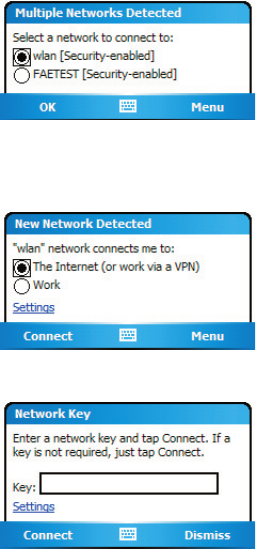
106 Getting Connected
To connect to a wireless network
1. After Wi-Fi has been turned on, your device then
scans for available wireless networks in your area. The
network names of the detected wireless networks will
be displayed on a pop-up message window. Tap the
desired wireless LAN, then tap OK.
2. On the next pop-up message window, tap The Internet
if the wireless LAN connects your device to the Internet.
Otherwise, tap Work if the wireless LAN connects your
device to a private network.
3. If the wireless LAN is secured by a network key, enter
this key, then tap Connect.
Next time you use your device to detect wireless
networks, you will not see the pop-up message
windows again, and you will not be prompted to enter
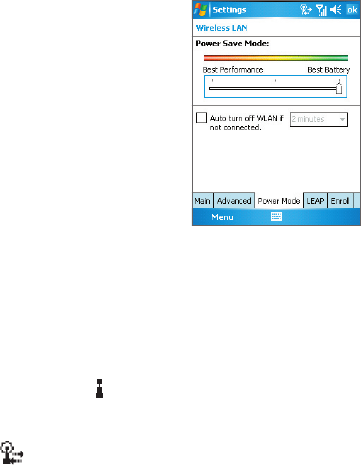
Getting Connected 107
the network key of the previously accessed wireless
network (unless you perform a hard reset which will
erase custom settings on your device).
Note Wi-Fi networks are self-discoverable, which means no
additional steps are required for your device to connect to
a Wi-Fi network. It may be necessary to provide a username
and password for certain closed wireless networks, however.
To save battery power while connected to a wireless
network
1. Tap Start > Settings > Connections tab > Wireless
LAN to open the Wireless LAN Settings screen.
2. On the Power Mode tab of
the Wireless LAN Settings
screen, move the Power
Save Mode slider to a
position that optimizes
performance with the least
power consumption.
For example, move the
slider to the left (Best
Performance) to have
the optimal WLAN
performance; move to
the right (Best Battery)
to obtain the maximum
battery usage.
To check the wireless LAN status
You can check the current wireless connection status from the
following three screens of your device:
• Title bar. When you enable Wi-Fi on your device, the
Wi-Fi ON icon ( ) will appear on the title bar.
After Wi-Fi is turned on, your device scans for available
wireless networks and the wireless signal icon
( ) appears on the title bar. The arrows in this icon
will move back and forth while your device is scanning
for a wireless LAN signal. Once your device successfully
connects to a wireless LAN, the arrows stop moving.
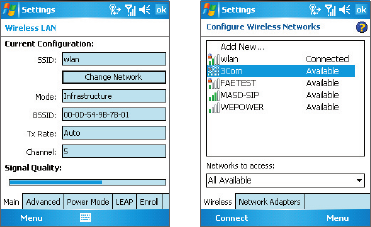
108 Getting Connected
• Wireless LAN screen - Main tab. Here, it shows the
name of the wireless network that your device is
currently connected to. The configuration and signal
quality of the wireless network are also shown.
• Configure Wireless Networks screen. Tap Start >
Settings > Connections tab > Wi-Fi > Wireless tab.
This screen displays the wireless networks currently
available.
Wi-FI: Wireless tabWireless LAN: Main tab
• To connect to a wireless network in the list, tap and
hold on the desired network, then tap Connect.
• Tap a wireless network in the list to view or change
its connection settings.
• You can also add new wireless networks, if available,
by tapping Add New.
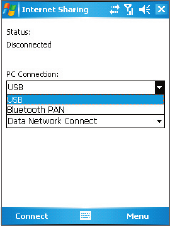
Getting Connected 109
6.6 Using Internet Sharing
Internet Sharing connects your PC or notebook computer to
the Internet by using your device’s data connection. You can
choose to connect via USB or Bluetooth.
Follow the procedure in this section to set up your device
as a USB modem. To learn how to set up your device as a
Bluetooth modem, see “Use the device as a Bluetooth modem”
in this chapter.
Notes • Make sure you have set up a phone dial-up modem
connection on your device. If your device has not been set
up with a data connection yet, tap Menu > Connection
Settings on the Internet Sharing screen. For more
information about setting up a phone dial-up connection,
see "To set up a dial-up connection to your ISP".
•
If you want to use a USB cable connection, you must first
install Microsoft ActiveSync version 4.2 or later on the
computer.
•
Before using Internet Sharing, disable ActiveSync on your
computer.
To set up your device as a USB
modem
1. On your device, tap Start
> Programs > Internet
Sharing.
2. In the PC Connection list,
select USB.
3. In the Network
Connection list, select the
name of the connection
that your device uses to
connect to the Internet.
4. Plug in the USB cable between your device and the
computer.
5. Tap Connect.
To end the Internet connection
• On the Internet Sharing screen, tap Disconnect.
110 Getting Connected
6.7 Using Terminal Services Client
The Terminal Services Client allows you to log on to a PC
running Terminal Services or Remote Desktop, and use all
the resources available on that PC. For example, instead of
running Word Mobile on your device, you can run the PC
version of Word and access the .doc files available on that PC.
To connect to a Terminal Server
1. On your device, tap Start > Programs > Terminal
Services Client.
2. Enter the server name.
3. You can also select a server name in Recent servers if
you have recently connected to a server.
4. Select the Limit size of server desktop to fit on this
screen check box if you want to use programs that have
been specifically sized for use with your device.
5. Tap Connect.
To navigate within Terminal Services Client
When connected to a remote server, you may notice that the
screen is displaying more than one horizontal and vertical
scroll bar. Use these scroll bars to either scroll the contents
on the PC, or to scroll the PC display through the Terminal
Services Client window.
To make sure you are scrolling the PC display through
Terminal Services Client, use the five directional buttons at
the bottom of the Terminal Services Client window. To better
fit information on the screen, select the Limit size of server
desktop to fit on this screen check box. For best results, the
programs on your desktop PC should be maximized.
To disconnect without ending a session
1. From the Terminal Services Client screen on your device,
tap Start > Shutdown.
2. Tap Disconnect.
Getting Connected 111
Notes • Do not use the Start menu on your device.
•
If a network administrator has configured Terminal
Services Client on your device to reconnect to
disconnected sessions, and you previously disconnected
from a Terminal Server without ending the session, the
Terminal Services Client reconnects to that session.
To disconnect after ending a session
1. From the Terminal Services Client screen on your device,
tap Start > Shutdown.
2. Tap Log Off.
112 Getting Connected

7.1 E-mail and Text Messages
7.2 MMS Messages
7.3 Pocket MSN
7.4 Calendar
7.5 Contacts
7.6 Tasks
7.7 Notes
Chapter 7
Exchanging Messages and
Using Outlook
114 Exchanging Messages and Using Outlook
7.1 E-mail and Text Messages
Messaging is where all of your e-mail accounts and your
text message account are located. You can send and receive
Outlook e-mail, Internet e-mail through an Internet service
provider (ISP), as well as SMS (Short Messaging Service) text
messages using your mobile phone network. You can also
access e-mail from work using a VPN connection.
E-mail Setup Wizard
Before you can send and receive e-mails, you need to set up
your e-mail account on your device. The E-mail Setup Wizard
makes it easy and simple to set up your Outlook e-mail and
POP3/IMAP4 accounts on your device.
To set up e-mail accounts using E-mail Setup Wizard
1. Tap Start > Messaging.
2. Tap Menu > Tools > New Account to access the E-mail
Setup Wizard.
3. The E-mail Setup Wizard guides you step-by-step
through the setup process.
For more information on setting up your Outlook e-mail
account, see “Set up Outlook e-mail”. For information on POP3
or IMAP4 setup, see “Set up a POP3/IMAP4 e-mail account”.
Set up Outlook e-mail
When starting ActiveSync on your computer for the first time,
the Synchronization Setup Wizard prompts you to set up a
synchronization relationship. This allows you to synchronize
Outlook e-mail and other information between your device
and your computer or the Exchange Server. If you have
already set up synchronization through the wizard, then
your device is ready to send and receive Outlook e-mail. For
information about the Synchronization Setup Wizard, see “To
install and set up ActiveSync on the computer” in Chapter 4.
If you have not set up a synchronization relationship yet, do
the following to set up your device to synchronize Outlook
e-mail:
Exchanging Messages and Using Outlook 115
1. To synchronize remotely, you need to set up and
connect to an over-the-air connection. For more details,
see the procedures in “Connecting to the Internet” in
Chapter 6.
2. Disconnect your device from your computer or LAN. (If
you have an over-the-air connection, there is no need to
disconnect).
3. Tap Start > Programs > ActiveSync.
4. If you want to synchronize e-mails directly with the
Exchange Server on a private network such as your
corporate network, follow the steps in “Synchronize
Outlook information with Exchange Server” in Chapter
4.
5. Choose which information types to synchronize. Make
sure E-mail is selected. For details, follow the steps
in “To change which information is synchronized” in
Chapter 4.
Everytime you want to manually send or receive Outlook
e-mail on your device, just connect your device to your
computer, LAN, or over-the-air connection, then tap Sync
on the ActiveSync screen or tap Menu > Send/Receive in
Outlook on your device.
For details about scheduling automatic synchronization or
setting a synchronization time with the Exchange Server, see
“Schedule synchronization with Exchange Server” in Chapter
4.
Set up a POP3/IMAP4 e-mail account
Set up a POP3 or IMAP4 e-mail account on your device if you
have an e-mail account with an Internet service provider (ISP)
or an account that you access using a VPN server connection
(typically a work account).
1. Tap Start > Messaging.
2. Tap Menu > Tools > New Account.
3. On the E-mail Setup screen, select Other (POP3/IMAP)
in the Your e-mail provider list, then tap Next.

116 Exchanging Messages and Using Outlook
4. Enter your e-mail address, then tap Next. Auto
configuration attempts to download necessary e-mail
server settings so that you do not need to enter them
manually.
5. Once Auto configuration has finished, tap Next.
6. Enter your name (the name you want displayed when
you send e-mail), user name, and password; tap Next.
Select the Save password check box if you want to save your
password so that you do not need to enter it again.
If Auto configuration was successful, the Your name and
User name fields automatically get populated. Tap Next, then
Finish to complete setting up your account, or tap Options
under Server information to access additional settings. For
example:
• Change the time intervals for downloading new
messages.
• Limit the amount of messages that are downloaded and
authentication method for outgoing mails.
• Download full messages or parts of messages.
If Auto configuration is unsuccessful or you have an account
you access using a VPN server connection, contact your ISP or
network administrator for the following information and enter
it manually:
Setting Description
User name Enter the user name assigned to you by your
ISP or network administrator. This is often the
first part of your e-mail address, which appears
before the at sign (@).
Password Choose a strong password. You have the
option to save your password so you do not
need to enter it each time you connect to your
e-mail server.
Account type Select POP3 or IMAP4.
Account name Enter a unique name for the account, such as
Work or Home. This name cannot be changed
later.

Exchanging Messages and Using Outlook 117
Setting Description
Incoming mail
server
Enter the name of your e-mail server (POP3
or IMAP4).
Outgoing mail
server
Enter the name of your outgoing e-mail server
(SMTP).
Domain Not required for an account with an ISP. May
be required for a work account.
Require SSL
connection
Select this to ensure you always receive e-mail
for this account using an SSL connection. This
enables you to receive personal information
more securely. Please note that if you select
this and your ISP does not support an SSL
connection, you will not be able to connect to
receive e-mail.
Outgoing
mail requires
authentication
Select this if your outgoing e-mail server
(SMTP) requires authentication. Your user
name and password from above will be used.
Use separate
settings
Select this if your outgoing e-mail server
requires a different user name and password
than the ones you entered before.
Outgoing server settings:
User name Enter your user name for the outgoing e-mail
server.
Password Enter your password for the outgoing e-mail
server.
Domain Enter the domain of the outgoing e-mail
server.
Require SSL for
outgoing mail
Select this to ensure you always send e-mail
from this account using an SSL connection.
This enables you to send personal information
more securely. Note that if you select this and
your ISP does not support an SSL connection,
you will not be able to send e-mail.
Tip You can set up several e-mail accounts in addition to your
Outlook e-mail account.
118 Exchanging Messages and Using Outlook
Send and receive messages
To compose and send a message
1. In the message list, tap Menu > Go To and select an
account.
2. Tap New.
3. Enter the e-mail address or mobile phone number
of one or more recipients, separating them with a
semicolon. To access addresses and phone numbers
from Contacts, tap To.
4. Enter your message. To quickly add common messages,
tap Menu > My Text and tap a desired message.
5. To check the spelling, tap Menu > Spell Check.
6. Tap Send.
Tips • To enter symbols, tap Shift using the on-screen keyboard.
To access more symbols, use the Symbol Pad. See Chapter
2 for details.
• To set the priority, tap Menu > Message Options.
• If you are working offline, e-mail messages are moved
to the Outbox folder and will be sent the next time you
connect.
• If you are sending a text message and want to know if it
was received, before composing the message, tap Menu
> Tools > Options. Tap Text Messages and select the
Request delivery notifications check box.
To reply to or forward a message
1. Open the message and tap Reply, or Menu > Reply All,
or Menu > Forward.
2. Enter your response. To quickly add common messages,
tap Menu > My Text and tap a desired message.
3. To check the spelling, tap Menu > Spell Check.
4. Tap Send.
Tips • To see more header information, scroll up.
• To always include the original message, from the list view,
tap Menu > Tools > Options > Message tab, and select
the When replying to e-mail, include body check box.
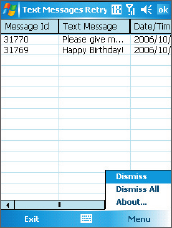
Exchanging Messages and Using Outlook 119
• In the Outlook E-mail account, you will send less data if
you do not edit the original message. This may reduce
data transfer costs based on your rate plan.
Warning! There are two types of storage on the device memory,
the data storage and program storage. When the data
storage reaches below 0.5MB, a warning message
appears to remind you to remove files and free up
some data storage space. Make sure you delete some
files or transfer them to a memory card.
If you do not delete files and continue to receive text,
e-mail, and MMS messages, new incoming messages
will automatically be saved to the program storage
when the data storage is full. Messages that are stored
on the program storage will be lost when you power
off your device.
To automatically resend SMS text messages that failed
delivery
If SMS text messages were not successfully sent due to
network problem or loss of signal coverage, they will
be queued in the Text Messages Retry program and
automatically resent. While text messages remain queued,
you can choose to delete some or all of them by following
these steps:
1. Tap Start > Programs >
Text Messages Retry.
2. Do one of the following:
• To delete a text
message, select the
message then tap
Menu > Dismiss.
• To delete all queued
text messages, tap
Menu > Dismiss All.
120 Exchanging Messages and Using Outlook
To exclude your e-mail address when replying to all
When you reply to all the recipients of an e-mail, your own
e-mail address will also be added to the recipient list. You
can customize ActiveSync so that your e-mail address will be
excluded from the recipient list.
1. In ActiveSync on your device, tap Menu > Options.
2. Select the E-mail information type and tap Settings.
3. Tap Advanced.
4. In the Primary e-mail address text box, enter your e-
mail address.
5. Tap OK.
To add an attachment to an e-mail message
1. In a new message, tap Menu > Insert and tap the item
you want to attach: Picture, Voice Note, or File.
2. Select the file you want to attach, or record a voice note.
To receive attachments
An attachment sent with an e-mail message or downloaded
from the server appears below the subject of the message.
Tapping the attachment opens the attachment if it has been
fully downloaded, or marks it for download the next time you
send and receive e-mail. You can also download attachments
automatically with your messages if you have an Exchange
Server mail account.
If you have an Outlook e-mail account, do the following:
1. Tap Start > Programs > ActiveSync.
2. Tap Menu > Options.
3. Tap E-mail > Settings, then select Include file
attachments.
If you have an IMAP4 e-mail account with an Internet service
provider (ISP) or an account that you access using a VPN
server connection (typically a work account), do the following:
1. Tap Start > Messaging.
2. Tap Menu > Tools > Options.
Exchanging Messages and Using Outlook 121
3. Tap the name of the IMAP4 account.
4. Tap Next until you reach Server information, and tap
Options.
5. Tap Next twice, and select Get full copy of messages
and When getting full copy, get attachments.
Tip To store attachments on a storage card rather than on the
device, tap Menu > Tools > Options > Storage tab, and
select the Store attachments on storage card check box.
Download messages
The manner in which you download messages depends on
the type of account you have:
• To send and receive e-mail for an Outlook e-mail
account, begin synchronization through ActiveSync. For
more information, see “Set up Outlook e-mail” in this
chapter.
• To send and receive e-mail messages for an e-mail
account that you have with an ISP or that you access
using a VPN server connection (typically a work
account), download messages through a remote e-
mail server. For more information, see “To download
messages from the server” later in this chapter.
• Text messages are automatically received when the
phone is turned on. When the phone is turned off,
messages are held by your service provider until the
next time the phone is turned on.
To download messages from the server
To send and receive e-mail messages for an e-mail account
that you have with an ISP or that you access using a VPN
server connection (typically a work account), you first need to
connect to the Internet or your corporate network, depending
on the account.
1. Tap Menu > Go To and tap the account you want to use.
2. Tap Menu > Send/Receive. The messages on your
device and e-mail server are synchronized: new
messages are downloaded to the device Inbox folder,
122 Exchanging Messages and Using Outlook
messages in the device Outbox folder are sent, and
messages that have been deleted from the server are
removed from the device Inbox folder.
Tip If you want to read the entire message, tap Menu >
Download Message while in the message window. If you
are in the message list, tap and hold the message, and tap
Download Message. The message will download the next
time you send and receive e-mail. This will also download
message attachments if you selected those options when
you set up the e-mail account.
Individually sign and encrypt a message
Encrypting an Outlook e-mail message protects the privacy
of the message by converting it from plain, readable text
into cipher (scrambled) text. Only the recipient who has the
authorization key can decipher the message.
Digitally signing a message applies your certificate with the
authorization key to the message. This proves to the recipient
that the message is from you and not from an imposter or a
hacker, and that the message has not been altered.
To digitally sign and encrypt a new message
1. In the message list, tap Menu > Go To > Outlook E-
mail.
2. Tap New.
3. Tap Menu > Message Options.
4. Select the Encrypt message and Sign message check
boxes, and tap OK.
Verify the digital signature on a signed
message you receive
1. Open the Outlook e-mail message that has been
digitally signed.
2. At the top of the message, tap View Signature Status.
3. Tap Menu > Check Certificate.
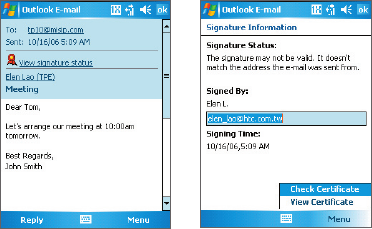
Exchanging Messages and Using Outlook 123
To view the details of the certificate in the message, tap Menu
> View Certificate.
Note There can be several reasons why a digital signature is not
valid. For example, the sender’s certificate may have expired,
it may have been revoked by the certificate authority, or the
server that verifies the certificate is unavailable. Contact the
sender to report the problem.
7.2 MMS Messages
Creating and sharing multimedia messages (MMS) with your
friends and family are easy with your device. You can attach
pictures or video, and an audio clip in an MMS. You can even
use the device camera to capture photos and video clips while
composing a new MMS message, and send them along with
your message.
To access MMS
1. Tap Start > Messaging.
2. Tap Menu > Go To > MMS.
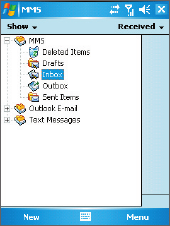
124 Exchanging Messages and Using Outlook
MMS message folders
Notes • Please note that MMS is a charged service. In order to
use MMS successfully, this has to be provisioned on
your mobile account. Please contact the wireless service
provider to have this provisioned as part of your calling
plan.
• Please ensure the size of the MMS is within the limits of
the wireless service provider if sending to another mobile
phone user or sending to an e-mail address.
Change MMS settings
When you send an MMS message, an SMS notification
message will first be sent to the recipient, while your MMS
message will be temporarily stored on an MMS server of your
wireless service provider. When others send you an MMS
message, similarly, the MMS message will be stored on the
MMS server until you retrieve it. Hence, your device must be
configured with the location of the MMS server for you to be
able to send and receive MMS messages on your device.
When you purchase your device, it is already preset with
your wireless service provider’s MMS server settings. If you
accidentally lost the preset settings or you changed to
another wireless service provider, follow the steps below to
configure MMS settings.
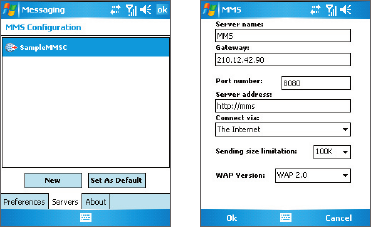
Exchanging Messages and Using Outlook 125
To configure MMS settings
1. Tap Start > Messaging.
2. Tap Menu > Tools > MMS Configuration. The MMS
Configuration screen appears.
3. In the Preferences tab, select or clear the provided
check boxes according to your needs. You can choose
to retrieve MMS messages immediately, accept or
reject messages, request a delivery receipt, specify a
resolution for images you send, and more.
4. Tap the Servers tab and check if your device is preset
with MMS server settings.
If there are no preset settings, tap New and enter the
following information, which you can get from your
wireless service provider:
• Server name. A descriptive name, such as your
wireless service provider name.
• Gateway. Location of the MMS server, which is
usually in the form of an IP address.
• Port number. HTTP port number used for
connecting to the MMS server and for file transfer.
• Server address. URL address of the MMS server.
• Connect via. Select the connection that your device
uses for MMS.
126 Exchanging Messages and Using Outlook
• Sending size limitation. Select the maximum
MMS message size allowed by your wireless service
provider.
• WAP version. Select either WAP 1.2 or WAP 2.0,
depending on which one is being used by your
wireless service provider.
5. Tap OK.
The MMS server settings will then be added as an entry
on the MMS Configuration screen.
Note If you add several MMS service providers to the MMS
Configuration screen, you can choose one as your default
MMS provider. Select the MMS provider's name in the list
then tap Set As Default.
Create and send MMS messages
After configuring the required settings, you can start to
compose and send MMS messages.
To compose an MMS message
You can compose MMS messages in a combination of various
slides, where each slide can consist of an image or video clip,
audio, and/or text.
1. On the MMS screen, do one of the following:
• Tap New > New Flix Message to create an MMS
message containing video and text, then skip to step
3.
• Tap New > New Pix Message to create an MMS
message containing images, audio, and text.
2. When you see the Choose a Media Message screen, tap
a preset template, or tap Custom to open a blank MMS
message.
Note If you prefer to always use a blank MMS message,
select the Always choose custom check box.
3. In To, enter the recipient’s phone number or e-mail
address directly, or tap To, Cc, or Bcc to choose a phone
number or an e-mail address from Contacts.
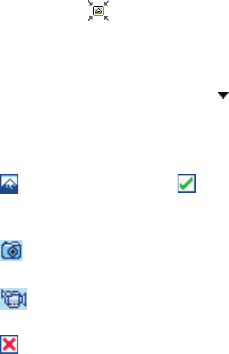
Exchanging Messages and Using Outlook 127
4. Enter a subject for your message.
5. Tap the Insert icon ( ) to select and insert a photo,
GIF animation, or video clip.
6. By default, My Documents will be displayed. Navigate
folders by tapping the folder thumbnails. To return to an
upper level folder, tap the Down arrow ( ) and tap the
folder name.
7. When selecting a photo, GIF animation, or video clip,
you can:
• Tap to view it first, then tap to insert the
selected photo or video clip into the MMS message
you are composing.
• Tap to take a photo and insert it into the MMS
message.
• Tap to record an MMS video clip and insert it
into the MMS message.
• Tap to quit selection and return to the MMS
message.
8. Enter text. See “To add text to an MMS message” for
details.
9. If you’re composing a pix message, you can insert
an audio clip. See “To add an audio clip to an MMS
message” for details.
10. Tap Send to send the MMS message.
Notes
You can also send an MMS message directly from the Pictures
& Videos or Camera program. Do one of the following:
• In Pictures & Videos, select a picture, GIF animation, or
video, and tap Menu > Send. In Select an account, tap
MMS if you're sending video, or tap New Pix Message
(MMS) if you're a sending an image or GIF animation.
•
Capture a photo or an MMS video clip using the camera,
and tap the Send icon. In the Send File dialog box, tap
Send via MMS.
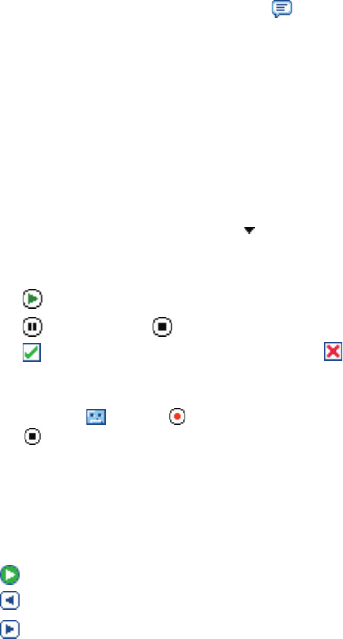
128 Exchanging Messages and Using Outlook
To add text to an MMS message
When entering text into an MMS message, you can do the
following:
• Tap inside the text box and enter your own text.
• Choose from common words or phrases. Tap to add
a text string from the Canned Text list.
Tip To edit or delete a phrase on the Canned Text list, tap and
hold a string, then tap Edit or Delete from the shortcut
menu. To create and add a new phrase to the list, tap New.
To add an audio clip to an MMS message
You can add an audio clip to a pix message.
1. While composing a pix message, tap Tap here to insert
an audio clip.
Open the folder that contains audio files. When
navigating folders, tap the Down arrow ( ) to return to
the upper folder.
2. Select an audio file. When selected, you can:
• Tap to play the audio clip.
• Tap to pause, or tap to stop playback.
• Tap to insert it into your MMS message, or tap
to quit selection and return to your MMS message.
• To record a new audio clip and add it to your MMS
message, tap then tap to start recording,
and to stop recording. The new audio clip is
automatically inserted into your MMS message.
To add slides
If you’re composing a pix message, you can add more slides to
your message by tapping Edit > Insert Slide.
While on a slide, you can:
• Tap to preview the entire MMS message.
• Tap to go to the previous slide.
• Tap to go to the next slide.

Exchanging Messages and Using Outlook 129
To customize the background color, text alignment and
other options
While composing your MMS message, you can do the
following:
• Tap Options > Background to choose a background
color from the list.
• Tap Options > Text on Top to place text above the
photo, GIF animation, or video.
• Tap Options > Text Below to place the text below the
photo, GIF animation, or video.
• Tap Options > Message Options to specify the sending
time, validity, priority, class, and other settings for a
message.
• Tap Edit > Attachments to include a contacts card,
calendar appointment, or any file as an attachment.
To create an MMS message from a template
• While on an MMS message, tap Edit > New from
Template to compose a message using a predefined
template.
Note To save a message as a template, open the message and tap
Edit > Save as Template.
View and reply MMS messages
To view an MMS message
• Use the playback controls , , and .
• Tap Menu > Objects to see a list of files included in the
message. On the Message Objects screen, you can do
the following:
• To save a file, select it, and tap Tools > Save.
• To use an audio file as a ring tone, tap Tools > Set as
Ringtone.

130 Exchanging Messages and Using Outlook
To reply to an MMS message
• Tap Menu > Reply to reply to the sender of the
message, or tap Menu > Reply All to reply to all persons
listed in To, Cc, and Bcc of the message.
Warning! There are two types of storage on the device memory,
the data storage and program storage. When the data
storage reaches below 0.5MB, a warning message
appears to remind you to remove files and free up
some data storage space. Make sure you delete some
files or transfer them to a memory card.
If you do not delete files and continue to receive text,
e-mail, and MMS messages, new incoming messages
will automatically be saved to the program storage
when the data storage is full. Messages that are stored
on the program storage will be lost when you power
off your device.
7.3 Pocket MSN
Pocket MSN delivers the features of Hotmail and MSN
Messenger to your device. With MSN Messenger, you can do
the following:
• Send and receive instant messages.
• See which contacts are online or offline.
• Subscribe to status updates for selected contacts so you
know when they come online.
• Block contacts from seeing your status or sending you
messages.
Before you can use MSN Messenger, your device must be
connected to the Internet. For information about setting up
an Internet connection, see “Connecting to the Internet” in
Chapter 6.
Note You must have either a Microsoft .NET Passport or Hotmail
account to use MSN Messenger. If you have a Hotmail.com or
MSN.com e-mail address, you already have a Passport. To get
a Passport account, go to http://www.passport.com. To get
a Hotmail account, go to http://www.hotmail.com.
Exchanging Messages and Using Outlook 131
To start MSN Messenger
1. Tap Start > Programs > Pocket MSN.
2. Tap MSN Messenger.
To sign in or out
• To sign in, tap anywhere on the MSN Messenger screen.
Enter the e-mail address and password for your Passport
or Hotmail account, and tap Sign In. Signing in may
take several minutes, depending on your connection
speed.
• To sign out, tap Menu > Sign Out. Your status changes
to Offline.
To add or delete contacts
• To add a contact, tap Menu > Add a Contact, and
follow the instructions on the screen.
• To delete a contact, tap and hold the contact's name,
and tap Delete Contact.
To send an instant message
1. Tap the contact to whom you want to send a message.
2. Enter your message in the text entry area at the bottom
of the screen, and tap Send.
Tip To quickly add common phrases, tap Menu > My Text and
select a phrase in the list.
132 Exchanging Messages and Using Outlook
7.4 Calendar
Use Calendar to schedule appointments, including meetings
and other events. Your appointments for the day can be
displayed on the Today screen. If you use Outlook on your PC,
you can synchronize appointments between your device and
PC. You can also set Calendar to remind you of appointments
with a sound or flashing light, for example.
You can look at your appointments in several different
views (Day, Week, Month, Year, and Agenda). To see detailed
appointment information in any view, tap the appointment.
To schedule an appointment
1. Tap Start > Calendar.
2. Tap Menu > New Appointment.
3. Enter a name for the appointment, and enter
information such as start and end times.
4. To schedule an all-day event, in the All Day box, tap Yes.
5. When finished, tap OK to return to the calendar.
Notes •
All-day events do not occupy blocks of time in Calendar;
instead, they appear in banners at the top of the calendar.
• To cancel an appointment, tap the appointment and tap
Menu > Delete Appointment.
Tip To have the time entered automatically in Day view, tap the
time slot for the new appointment, and tap Menu > New
Appointment.
To send a meeting request
Use Calendar to schedule meetings via e-mail with contacts
who use Outlook or Outlook Mobile.
1. Tap Start > Calendar.
2. Schedule a new appointment, or open an existing one
and tap Edit.
3. Tap Attendees.
4. Tap the name of the contact you want to invite.
Exchanging Messages and Using Outlook 133
5. To invite each additional attendee, tap Add and tap the
name.
6. Tap OK.
7. The meeting request will be sent to the attendees the
next time you synchronize your device with your PC.
Note When attendees accept your meeting request, the meeting is
automatically added to their schedules. When their response
is sent back to you, your calendar is updated as well.
To set a default reminder for all new appointments
You can have a reminder automatically turned on for all new
appointments you schedule.
1. Tap Start > Calendar.
2. Tap Menu > Options > Appointments tab.
3. Select the Set reminders for new items check box.
4. Set the time when you want the reminder to alert you.
5. Tap OK to return to the calendar.
7.5 Contacts
Contacts is your address book and information storage for the
people and businesses you communicate with. Store phone
numbers, e-mail addresses, home addresses, and any other
information that relates to a contact, such as a birthday or an
anniversary date. You can also add a picture or assign a ring
tone to a contact.
From the contact list, you can quickly communicate with
people. Tap a contact in the list for a summary of contact
information. From there, you can call or send a message.
If you use Outlook on your PC, you can synchronize contacts
between your device and PC.
To create a contact on your device
1. Tap Start > Contacts.
2. Tap New and enter the contact information.
3. When finished, tap OK.
134 Exchanging Messages and Using Outlook
Tips •
If someone who is not in your list of contacts calls you,
you can create a contact from Call History by tapping
and holding a phone number and then tapping Save to
Contacts from the shortcut menu.
•
To save a phone number that is contained in a message,
tap the phone number, then tap Menu > Save to
Contacts.
•
In the list of contact information, you’ll see where you can
add a picture or assign a ring tone to a contact.
To change contact information
1. Tap Start > Contacts.
2. Tap the contact.
3. Tap Menu > Edit and enter the changes.
4. When finished, tap OK.
To work with the contact list
There are several ways to use and customize the contact list.
Here are a few tips:
1. Tap Start > Contacts.
2. In the contact list, do any of the following:
• In Name view, you can search for a contact by
entering a name or number, or by using the
alphabetical index. To switch to Name view, tap
Menu > View By > Name.
• To see a summary of information about a contact,
tap the contact. From there you can also make a call
or send a message.
• To see a list of available actions for a contact, tap and
hold the contact.
• To see a list of contacts employed by a specific
company, tap Menu > View By > Company, then
tap the company name.
Exchanging Messages and Using Outlook 135
To find a contact on your device
There are several ways to find a contact when your contact list
is long.
1. Tap Start > Contacts.
2. If you are not in Name view, tap Menu > View By >
Name.
3. Do one of the following:
• Begin entering a name or phone number in the
provided text box until the contact you want is
displayed. To show all contacts again, tap the text
box and clear the text, or tap the arrow to the right
of the text box.
• Use the alphabetical index displayed at the top of
the contact list.
• Filter the list by categories. In the contact list, tap
Menu > Filter, then tap a category you’ve assigned
to a contact. To show all contacts again, select All
Contacts.
To find a contact online
In addition to having contacts on your device, you can also
access contact information from your organization’s Global
Address List (GAL). GAL is the address book that contains
all user, group, and distribution list e-mail addresses of your
organization, and it is stored on the Exchange Server. By
having direct online access to it from your device, it is quick
and easy for you to plan a meeting and e-mail a meeting
request immediately to anyone in your organization.
Access to the GAL is available if your organization is running
Microsoft Exchange Server 2003 SP2 and you have completed
your first synchronization with the Exchange Server.
1. Synchronize with Exchange Server if you have never
done so.
2. Tap Start > Contacts > Menu > View By > Name.
3. Do any of the following:
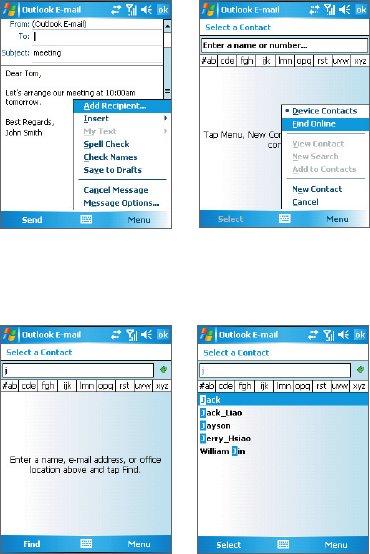
136 Exchanging Messages and Using Outlook
• In Contacts, tap Menu > Find Online.
• In a new message, tap the To box. Tap Menu > Add
Recipient > Menu > Find Online.
• In a new meeting request using Calendar, tap
Attendees and then tap Menu > Find Online.
4. Enter the part or full contact name and tap Find. Tap
Select to choose the desired contact(s) from the list.
Notes • Your device must be set up with a data connection.
• You can search on the following information as long as
that information is included in your organization’s GAL:
First name, Last name, E-mail name, Display name, E-mail
address, or Office location.
Exchanging Messages and Using Outlook 137
To send contact information via text messaging
1. Tap Start > Contacts, then select a contact.
2. Tap Menu > Send Contact > Text Message.
3. Select the contact information you want to send, then
tap Done.
4. In the new text message, enter the mobile phone
number of the recipient, then tap Send.
7.6 Tasks
Use Tasks to keep track of things you need to do. A task can
occur once or repeatedly (recurring). You can set reminders for
your tasks and you can organize them using categories.
Your tasks are displayed in a task list. Overdue tasks are
displayed in red.
To create and categorize a task
1. Tap Start > Programs > Tasks.
2. Tap Menu > New Task, enter a subject for your task, and
fill in information such as start and due dates, priority,
and so on.
3. Specify the type of category for your task, so that it can
be grouped with other related tasks. Tap Categories,
then select a preset category (Business, Holiday,
Personal, or Seasonal), or tap New to create your own
category.
4. When finished, tap OK.
Tip You can easily create a short, to-do type task. Simply tap the
Tap here to add a new task box, enter a subject, and tap the
Enter button on the on-screen keyboard. If the task entry box
is not available, tap Menu > Options and select the Show
Tasks entry bar check box.
138 Exchanging Messages and Using Outlook
To change the priority of a task
Before you can sort tasks by priority, you need to specify a
priority level for each task.
1. Tap Start > Programs > Tasks.
2. Tap the task you want to change the priority for.
3. Tap Edit, and in the Priority box, tap a priority level.
4. Tap OK to return to the task list.
Note All new tasks are assigned a Normal priority by default.
To set a default reminder for all new tasks
You can have a reminder automatically turned on for all new
tasks you create.
1. Tap Start > Programs > Tasks.
2. Tap Menu > Options.
3. Select the Set reminders for new items check box.
4. Tap OK to return to the task list.
Note The new tasks must have due dates set in order for the
reminder to take effect.
To show start and due dates in the task list
1. Tap Start > Programs > Tasks.
2. Tap Menu > Options.
3. Select the Show start and due dates check box.
4. Tap OK.
To locate a task
When your list of tasks is long, you can display a subset of the
tasks or sort the list to quickly find a specific task.
1. Tap Start > Programs > Tasks.
2. In the task list, do one of the following:
• Sort the list. Tap Menu > Sort By, and tap a sort
option.
• Filter the list by category. Tap Menu > Filter, and tap
the category you want displayed.
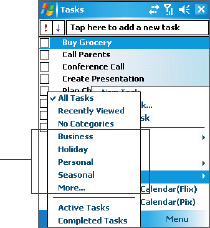
Exchanging Messages and Using Outlook 139
Tap one of these
categories
Tip To filter your tasks further, tap Menu > Filter > Active Tasks
or Completed Tasks.
7.7 Notes
Notes helps you to quickly capture thoughts, questions,
reminders, to-do lists, and meeting notes. You can create
handwritten and typed notes, record voice notes, convert
handwritten notes to text for easy readability, and send notes
to others.
Enter information in Notes
There are several ways to enter information in a note. You
can enter typed text by using the on-screen keyboard or
handwriting recognition software. You can use the stylus to
write or draw directly on the screen.
To set the default input mode for Notes
If you frequently add drawings to your notes, you may find it
helpful to set Writing as the default input mode. If you prefer
typed text, select Typing.
1. Tap Start > Programs > Notes.
2. In the note list, tap Menu > Options.
3. In the Default mode box, tap one of the following:
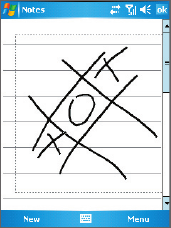
140 Exchanging Messages and Using Outlook
• Writing if you want to draw or enter handwritten
text in a note.
• Typing if you want to create a typed note.
4. Tap OK.
To create a note
1. Tap Start > Programs > Notes. In the note list, tap New.
2. Tap the Input Selector arrow next to the Input Method
icon on the menu bar, tap the input method you want,
and enter your text.
3. If the Input Selector arrow is not displayed, tap the
Input Method icon.
4. When finished, tap OK to return to the note list.
Notes •
To select handwritten text, tap and hold next to the
writing. As soon as dots appear, and before they form a
complete circle, quickly drag across the writing.
• If a letter crosses three ruled lines, it is treated as a drawing
rather than text.
To draw in a note
1. Tap Start > Programs > Notes.
2. In the note list, tap New.
3. To draw on the screen, use the stylus like a pen.
Drawing on the screen

Exchanging Messages and Using Outlook 141
4. A selection box appears around your drawing.
5. When finished, tap OK to return to the note list.
Note To select a drawing (for example, to copy or delete it), tap
and hold the drawing briefly. When you lift the stylus, the
drawing is selected.
Record a voice note
You can create a stand-alone recording (voice note) or you can
add a recording to a note.
To create a voice note
1. Tap Start > Programs > Notes.
2. Do one of the following:
• To create a stand-alone recording, record from the
note list.
• To add a recording to a note, create or open a note.
3. If you do not see the Recording toolbar, tap Menu >
View Recording Toolbar.
4. Tap the Record icon ( ) to begin recording.
5. Hold your device’s microphone near your mouth or
other source of sound.
6. Tap the Stop icon ( ) when finished recording.
7. If you are adding a recording to a note, tap OK to return
to the note list when finished.
8. If you are recording in an open note, an icon will appear
in the note.
9. If you are creating a stand-alone recording, the
recording will appear in the note list.
Tip To quickly create a recording, press and hold the VOICE
COMMAND button, then you can begin to record after a beep
sound. Release the button when you are finished.
142 Exchanging Messages and Using Outlook
To change recording formats
1. Tap Start > Settings > Personal tab > Input.
2. Tap the Options tab, and select the desired format you
want in the Voice recording format list.
3. Tap OK.
Note
You can also change recording formats from within Notes. In
the note list, tap Menu > Options > Global Input Options
link (at the bottom of the page), then tap the Options tab.

Chapter 8
Experiencing Multimedia
8.1 Using Camera
8.2 Using Pictures & Videos
8.3 Using Windows Media Player
8.4 Using Streaming Media Player
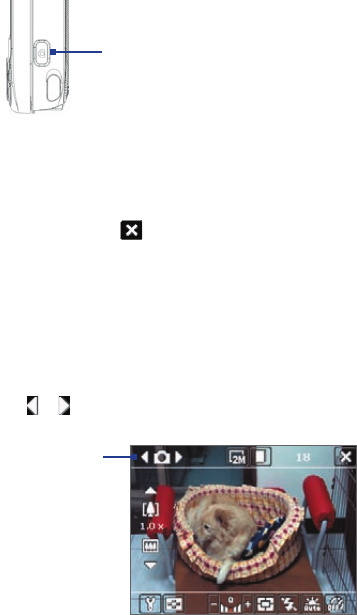
144 Experiencing Multimedia
8.1 Using Camera
Taking photos and capturing video clips along with audio is
easy with the built-in camera on your device.
To open the Camera screen
• Press the CAMERA button on your device; or
CAMERA button
• Tap Start > Programs > Camera; or
• Tap Start > Programs > Pictures & Videos > Camera
icon.
To exit the Camera
• Tap the Exit icon ( ).
Capture modes
The Camera program on your device allows you to capture
pictures and video clips by using various built-in modes with
flexibility. The Camera is set to the Photo capture mode by
default. The upper left corner of the screen displays the active
capture mode. To switch to other capture modes, do any of the
following
:
• Tap or on the screen.
• Press NAVIGATION left or right.
Current capture mode

Experiencing Multimedia 145
The available capture modes of the main camera are as
follows:
• Photo: Captures standard still images.
• Video: Captures video clips, with or without
accompanying audio.
• MMS Video: Captures video clips suitable for sending
via MMS.
• Contacts Picture: Captures a still image and gives you
the option to immediately assign it as a Photo ID for a
contact.
• Picture Theme: Captures still images and places them
within frames.
• Panorama: Captures a sequence of still images
continuously in one direction, and allows stitching of all
the images to create a panoramic view of a scenery
• Sports: Captures a sequence of still images (3, 5, 7, or
10) automatically.
• Burst: Captures a sequence of still images (maximum
30) as long as the CAMERA button on the device or the
ENTER button on the NAVIGATION is kept pressed.
File formats supported
Using the above capture modes, the camera in your device
captures files in the following formats:
Capture type Format
Still image JPEG
Video MPEG-4 (.mp4)
H.263 (.3gp)
3GP2 (.3g2)
MMS Video MPEG-4 (.mp4)
H.263 (.3gp)
3GP2 (.3g2)
Panorama / Sports / Burst
JPEG
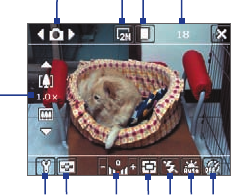
146 Experiencing Multimedia
Camera controls
Use the following device buttons and on-screen controls to
take photos or video clips and to modify settings.
The CAMERA button, ENTER button and Jog Wheel
The CAMERA button, ENTER button, and Jog Wheel can all be
used as the shutter release.
• Press to take a photo, or to take shots for a picture
theme or panorama.
• Press to start recording video; press again to stop
recording.
• To take consecutive shots in Sports mode, press shortly,
then move your device to follow the movement of your
subject.
• Press and hold when taking consecutive shots in Burst
mode.
The Navigation Control
• Press NAVIGATION up or down to increase or decrease
the zoom level.
• Press NAVIGATION left or right to go to the previous or
next sequential capture mode.
On-screen controls and indicators
Photo mode
6 7 8910 11
5
1 2 3 4
12
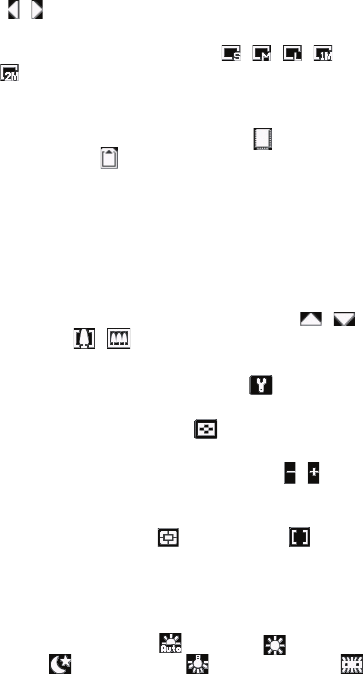
Experiencing Multimedia 147
1 Mode Switching control. Tapping the left/right arrow
( / ) on the screen allows you to switch the capture
mode.
2 Resolution. The resolution icon ( / / / /
) indicates the current resolution. Tap to toggle
among the different resolutions.
3 Storage. Tap to toggle between saving captured photos
or video clips on the device memory ( ) or on the
memory card ( ).
4 Remaining information indicator. In Photo, Contacts
Picture, Picture Theme, Panorama, Sports, and Burst
modes, this shows the remaining, available shots of
pictures based on current settings. In Video and MMS
Video modes, this shows the remaining duration that
can be recorded. While recording video, this shows the
recorded duration.
5 Zoom control. Tapping the up/down arrow ( / )
or tapping / on the screen allows you to zoom in
or zoom out.
6 Camera Settings. Tap the Tool icon ( ) to open the
Camera Settings screen.
7
Viewer. Tap the Viewer icon ( ) to open the Pictures &
Videos screen
.
8 Brightness. Tapping the minus/plus icon ( / )
decreases or increases the brightness level.
9 Metering Mode. Tap to toggle the metering mode
between Center Area ( ) and Average ( ).
10 Flash Light. Tap to turn on or off the flash light that is
located at the back of your device. Turn on the flash
light when taking shots in dark-lit environments.
11 White Balance. Tap to toggle among the different white
balance settings: Auto ( ), Daylight ( ),
Night ( ), Incandescent ( ), and Fluorescent ( ).
12 Self-timer. Tap to set the Self-timer to 2 seconds, 10
seconds, or off when in the Photo or Contacts Picture
mode. When you press the ENTER button or the
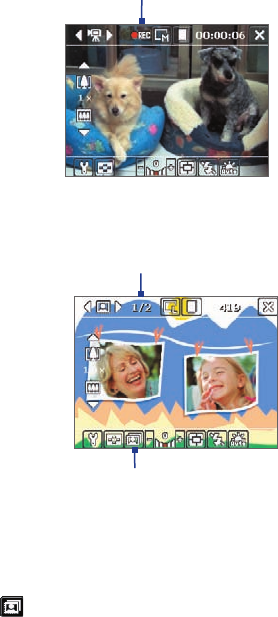
148 Experiencing Multimedia
CAMERA button to capture a still image, it starts to
count down, and then captures a still image after the
assigned time (2 seconds or 10 seconds).
Video mode
13
13 Recording indicator. This shows a red, blinking
indicator while video recording is in progress.
Picture Theme mode
14
15
14 Progress indicator. In Picture Theme, Panorama,
Sports, and Burst modes, this shows the total number of
consecutive shots.
15 Template Selector icon. In Picture Theme mode, tap
to toggle among the different templates.
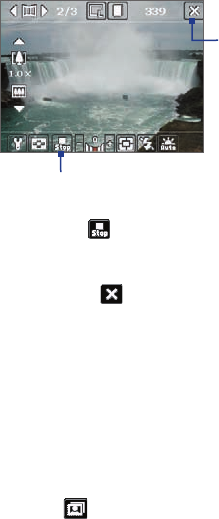
Experiencing Multimedia 149
Panorama mode
16
17
16 Stop. The Stop icon ( ) appears only in Panorama
mode. Tap this icon if you want to stop capturing the
remaining shots and start composing the panorama.
17 Exit. Tap the Exit icon ( ) to exit the Camera
program.
Still image capture modes
While using Still Image capture modes, such as Photo,
Contacts Picture, Picture Theme, Panorama, Sports,
and Burst, you can capture still image(s) by pressing the
CAMERA button or Jog Wheel, or the ENTER button on the
NAVIGATION. Still images will be saved in JPEG format.
While capturing an image in the Picture Theme capture mode,
you can select a preset template. To view and select from
different templates, tap on the Camera screen. Depending
on the chosen template, one or more photos may need to be
taken for the template.
Video capture mode
In Video capture mode, press the CAMERA button, Jog Wheel,
or the ENTER button to start recording a video clip. To stop
recording, press again.
Before you capture a video clip, you can set the file format
and specify the desired length of recording in terms of time
or file size on the Camera Settings screen. For information
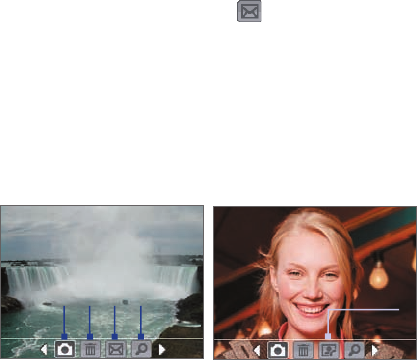
150 Experiencing Multimedia
about the available capture formats for video, see “File formats
supported” in this chapter.
MMS Video capture mode
The MMS Video capture mode makes it convenient for you
to capture a video file and then send it via MMS. Press the
CAMERA button, the ENTER button, or Jog Wheel to start
recording a video clip. To stop recording, press again.
The recording length of MMS video is fixed. Recording
automatically stops when the preset length is reached.
However, you can manually stop recording the video anytime.
The time indicator at the upper right side of the Camera
screen indicates the time limit.
Before capturing, you can set the capture format on the
Camera Settings screen. For information about the available
capture formats for MMS video, see “File formats supported” in
this chapter.
After you capture the video file, tap on the Review screen
to send the file through MMS.
The Review screen
After taking a still image or recording a video clip, you can
view the image or video clip on the Review screen. In
addition, you can tap the icons at the bottom of the Review
screen to delete a captured image or video, send it via e-mail
or MMS, and more.
Review screen icons
Contacts Picture mode
5
Photo, Video, MMS Video, Picture
Theme, and Panorama modes
1 2 3 4
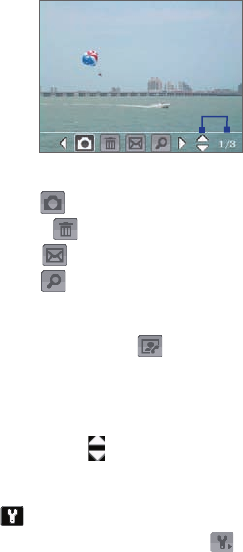
Experiencing Multimedia 151
Sports and Burst modes
6
1 Back. Tap to go back to the Camera screen.
2 Delete. Tap to remove the captured image or video.
3 Send. Tap to send via e-mail or MMS.
4 View. Tap to view the image in the Pictures & Videos
program, or play the captured video in Windows Media
Player.
5 Assign to Contacts. Tap to associate the photo to a
selected contact.
6 Browse. After you have taken photos in Sports or Burst
mode, the total number of consecutive shots is shown
in the lower right corner of the Review screen. Tap the
up/down arrow ( ) to browse through the sequence
of photos.
To change the display duration of the Review screen
1. Tap to open the Camera Settings screen.
2. On the Camera Settings screen, tap . The Advanced
menu then appears.
3. Tap Review Duration, then tap the desired time length
for displaying captures on the Review screen.
Zooming
While capturing a still image or a video clip by using the
camera, you can zoom in to make the object in focus move
closer, and you can zoom out to make the object move
farther away. In all capture modes, use NAVIGATION on your
device, or tap the triangular Up arrow above the Zoom Ratio

152 Experiencing Multimedia
indicator, to zoom in your subject. When the zooming limit is
reached, you will hear a beep. To zoom out, press NAVIGATION
down, or tap the Down arrow.
Zoom range
The camera zoom range for a picture or a video clip depends
on the capture mode and capture size.
The following is a summary for the main camera.
Capture
mode Capture size setting Zoom range
Photo 2M (1600 x 1200) No zooming available
1M (1280 x 960) No zooming available
Large (640 x 480) 1.0x to 4.0x
Medium (320 x 240) 1.0x to 8.0x
Small (160 x 120) 1.0x to 8.0x
Video CIF (352 x 288) No zooming available
Large (320 x 240) No zooming available
Medium (176 x 144) 1.0x to 2.0x
Small (128 x 96) 1.0x to 2.0x
MMS Video Medium (176 x 144) 1.0x to 2.0x
Small (128 x 96) 1.0x to 2.0x
Contacts
Picture
Large (480 x 640) No zooming available
Medium (240 x 320) 1.0x to 2.0x
Small (120 x 160) 1.0x to 4.0x
Picture
Theme
Determined by the current
template
Depends on the
size of the template
currently loaded
Panorama Large (640 x 480) 1.0x to 4.0x
Medium (320 x 240) 1.0x to 8.0x
Small (160 x 120) 1.0x to 8.0x
Sports Large (640 x 480) 1.0x to 2.0x
Medium (320 x 240) 1.0x to 8.0x
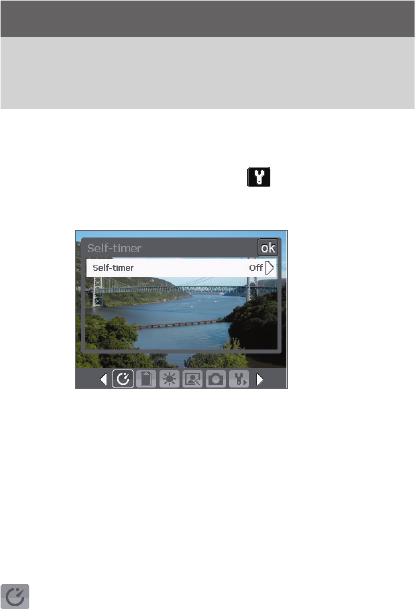
Experiencing Multimedia 153
Capture
mode Capture size setting Zoom range
Burst 1M (1280 x 960) No zooming available
Large (640 x 480) 1.0x to 2.0x
Medium (320 x 240) 1.0x to 8.0x
The Camera Settings screen
While capturing a still image or video clip using any
capture modes, tap the Tool icon ( ) to access the
Camera Settings screen. The Camera Settings screen
allows you to configure capture settings.
Camera Settings screen in Photo mode
When you tap the icons at the bottom of the Camera Settings
screen, different menus will appear. Some menus and options
may be available only in certain capture modes.
Tip You can also press the Navigation Control buttons to
navigate menus.
For more information about the different menus and settings,
see the succeeding sections.
Self-timer menu
• Self-timer. Select the Self-timer option for capturing
images: Off, 2 seconds, or 10 seconds. Selecting 2
seconds or 10 seconds delays the capturing by the
specified time after you press the CAMERA button, the
ENTER button, or Jog Wheel.

154 Experiencing Multimedia
Template menu
• Template. Select a template (in Picture Theme mode
only).
Panorama Settings menu
• Direction. Choose in what direction images will be
stitched in a panorama.
• Stitch Count. Select the desired number of snapshots
to be taken and stitched into a panorama.
• Auto Stitch. When the Auto Stitch is On, the camera
automatically stitches snapshots into one single file. If
Auto Stitch is Off, the snapshots are saved as separate
files.
Sports Settings menu
• Snapshots. Select the number of consecutive shots to
capture (in Sports mode).
Flash Light menu
• Flash Light. Set this option to On to turn on the flash
light (located at the back of your device) so that you can
shoot photos or video clips in a low-light environment.
The flash flight is available for use in all capture modes
except in Sports and Burst modes.
Ambience menu
• White Balance. Select a white balance setting type
such as Fluorescent, Night, etc. to suit your lighting
environment.
• Effect. Choose a special effect such as Grayscale, Sepia,
etc., to apply to your photos or video clips.
Capture Settings menu
• Resolution. Select the desired image or video size.
• Quality.
Select the JPEG image quality level for all
captured still images. You can choose from Basic,
Normal, Fine, and Super Fine
.
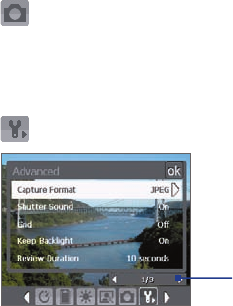
Experiencing Multimedia 155
• Metering Mode. Select a metering mode to allow
the camera to measure the amount of light in the
center and around the image and calculate the best-fit
exposure value before capturing. Choose either Center
Area to measure light using the center area of the
image or Average to measure light using the area all
around the image.
• Storage. Select where you want to save your files. You
can either save the files to the main memory or to a
storage card.
Capture Mode menu
• Mode. Switch between different capture modes such
as Photo, Video, Contacts Picture, and more. For more
information about these modes, see “Capture modes”
earlier in this chapter.
Advanced menu
Tap the left/right icon in this
bar to switch between the
menu pages in the Advanced
menu.
• Capture Format. Select the desired file format.
• Shutter Sound. Choose whether or not you want the
camera to make a shutter sound when you press the
CAMERA button, the ENTER button, or Jog Wheel to take
photos or record video clips.
• Grid (Photo mode only). Choose whether or not to
show a grid on the Camera screen. Showing a grid helps
you frame and center your subject more easily and
accurately.
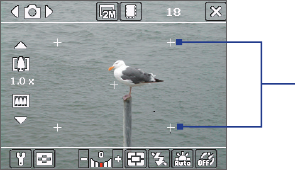
156 Experiencing Multimedia
Grid
• Keep Backlight. Choose whether to turn the backlight
on or off while using the camera. This overrides your
device backlight settings while you are using the
camera.
• Review Duration. Set a time length for displaying the
captured image/video on the Review screen before
automatically saving it and returning to the live Camera
screen. Select No Limit if you do not want to impose a
time limit. Select No Review to immediately return to
the live Camera screen after capturing.
• Flicker Adjustment. When taking indoor shots, flicker
on the camera screen may be caused by inconsistencies
between the vertical scan rate of the camera display and
the flicker frequency of fluorescent lighting. To reduce
flicker, you can change the flicker adjustment setting
to the proper frequency (50Hz or 60Hz) of the country
where your device is being used.
• Record with Audio. Select On to record audio with the
captured video clips. This is selected by default. If you
select Off and then capture a video clip, it will have no
audio.
• Prefix. Specify how to name captured images and video
clips. When Default is selected, the file name of each
new captured file is set to “IMAGE” or “VIDEO” followed
by a sequential number, for example: IMAGE_001.jpg.
You may also choose to name files using either the
current Date or Date & Time as the prefix.
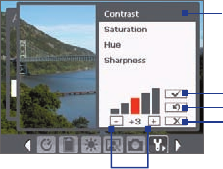
Experiencing Multimedia 157
• Counter. By default, the newly captured image or
video files are named with a prefix and some sequential
numbers, such as 001, 002, and so on. To reset the
numbering to “001” for your captured files, tap Reset.
• Recording Limit. Specify the maximum time or file size
for recording.
• Template Folder (in Picture Theme mode only). By
default, templates are stored in the \My Documents\
Templates folder on the device’s Main Memory. If you
transferred some templates to a storage card (via File
Explorer), set this option to Main + Card to specify that
templates are located in both the main memory and the
storage card.
• Adjust. This option allows you to adjust the camera
display properties, such as Contrast, Saturation, Hue,
and Sharpness.
2
3
4
1
5
1In the submenu, tap one of the properties to adjust.
Alternatively, press NAVIGATION up or down to select a
property.
2To increase/decrease the value, tap the plus/minus icon
or press NAVIGATION left or right. The live Camera screen
on the background immediately displays the effect of
changes.
3Tap to save the settings and close the submenu.
4Tap to reset all properties to their default.
5Tap to close the submenu without applying and saving
the changes.

158 Experiencing Multimedia
8.2 Using Pictures & Videos
The Pictures & Videos program collects, organizes, and
sorts images and video clips in the following formats on your
device.
File Type File Extensions
Image *.bmp, *.jpg, *.gif
GIF animation *.gif
Video *.avi, *.wmv, *.mp4, *.3gp, *.3g2
You can view the pictures as a slide show, beam them, send
them via e-mail, edit them, or set them as the background on
the Today screen.
To copy images, GIF animation files, and video clips to
your device
You can copy images, GIF animation files, and video files from
your PC and view them on your device.
• Copy the images, GIF animation files, and video files
from your PC or a storage card to the My Pictures folder
on your device. (You can also copy video files to the My
Videos folder.)
For more information about copying files from your PC to your
device, see ActiveSync Help on your PC.
Note You can also copy images, GIF animation files, and video files
from your PC to your device using a memory card. Insert the
memory card into the memory card slot on your device, then
copy the files from your PC to the folder you created on the
memory card.
To view pictures
1. Tap Start > Programs > Pictures & Videos. The images
in the My Pictures folder appear as thumbnails by
default.
2. Select an image and tap View.
If you cannot find the desired image in the default My
Pictures folder, go to another folder by tapping the
Down arrow ( ).
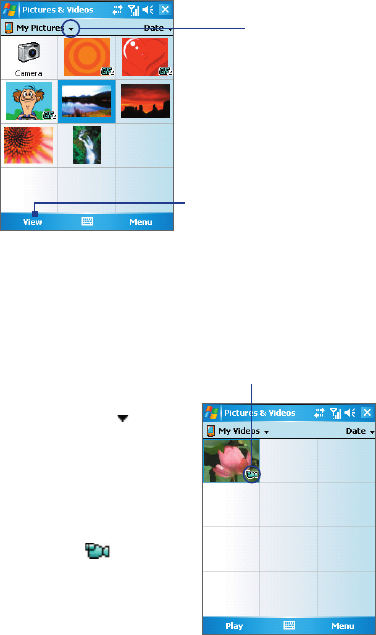
Experiencing Multimedia 159
To play GIF animation files
1. Tap Start > Programs > Pictures & Videos.
2. Select a GIF animation file and tap View. The GIF
Animation program then opens and plays the
animation.
The down arrow
Tap to view the selected image
To play videos with audio
1. Tap Start > Programs
> Pictures & Videos. By
default, the contents of
the My Pictures folder will
be shown.
2. To find the video clips
that you captured, tap
the down arrow ( ) next
to the My Pictures folder
and tap My Documents.
Next, tap My Videos.
Video clips are displayed
as thumbnails by default,
which appear with a
media icon ( ).
3. Tap to select a video and
play it in Windows Media
Player Mobile.
The media icon
160 Experiencing Multimedia
To view slide shows
You can view your pictures as a slide show on your device.
Pictures are shown in full-screen view with 5-second intervals
between slides.
1. Tap Start > Programs > Pictures & Videos.
2. Tap Menu > Play Slide Show.
Note You can specify how pictures are scaled to optimize their
display in a slide show. Tap Menu > Options, then tap
Portrait pictures or Landscape pictures on the Slide Show
tab.
Tap anywhere on the screen to display the Slide Show toolbar,
which you can use to stop or pause the slide show, rotate the
view, and more.
To sort pictures and video clips
If you store a large number of pictures or video clips on your
device, you may find it helpful to sort them to quickly find a
specific picture or clip. You can sort by name, date, and size.
1. Tap Start > Programs > Pictures & Videos.
2. Tap the sort list (labeled Date by default), and select the
item you want to sort by (Name, Date, or Size).
To delete a picture or video clip
Do any of the following to remove a picture or a video clip:
• Select a picture or video clip on the Pictures & Videos
screen, and tap Menu > Delete.
• Tap and hold the thumbnail of the picture you want to
delete, then tap Delete.
Tap Yes to confirm the deletion.
To edit a picture
You can rotate, crop, and adjust the brightness and color
contrast of your pictures.
1. Tap Start > Programs > Pictures & Videos.
2. Tap the picture you want to edit.
3. Tap Menu > Edit, and do any of the following:
Experiencing Multimedia 161
• To rotate a picture 90 degrees clockwise, tap Rotate.
• To crop a picture, tap Menu > Crop. Next, tap and
drag to select the area to crop. Tap inside the box to
crop, or tap outside the box to cancel cropping.
•
To adjust the brightness and contrast levels of a
picture, tap Menu
> Auto Correct.
Note To undo an edit, tap Menu > Undo. To cancel all unsaved
edits you made to the picture, tap Revert to Saved.
To set a picture as the Today screen background
You can use a picture as the background on the Today screen.
1. Tap Start > Programs > Pictures & Videos.
2. Select the picture you want to set as the background.
3. Tap Menu > Set as Today Background.
4. In Transparency level, select a higher percentage for
a more transparent picture, or a lower percentage for a
more opaque picture.
5. Tap OK.
To send pictures and video clips via e-mail
You can send pictures and video clips to other devices via
e-mail.
1. First, set up Messaging to send and receive messages.
2. From the program, select the item you want to send.
3. Tap Menu > Send, and select one account (such as
Outlook E-mail or MMS) to send the attached item.
4. A new message is created with the item attached.
5. Enter the recipient name and subject, and tap Send.
The message will be sent the next time you synchronize
your device.
Note Pictures and video clips are saved automatically before they
are sent.
To beam a picture or video clip
You can beam a picture or video file to another mobile device
using Infrared.
162 Experiencing Multimedia
1. Tap Start > Programs > Pictures & Videos.
2. Select the picture or video file you want to beam.
3. Tap Menu > Beam.
4. Select a device to beam the file to.
5. Tap OK.
To assign pictures to contacts
You can assign a picture to a contact so that you can easily
identify the contact at any point of time.
1. Tap Start > Programs > Pictures & Videos.
2. Select the picture you want to assign to a contact.
3. Tap Menu > Save to Contact.
4. Tap the contact, or navigate and tap Select to choose
the contact from your Contacts list.
To customize more image settings
1. Tap Start > Programs > Pictures & Videos.
2. Select the picture for which you want to configure
further settings.
3. Tap Menu > Options. The Options screen appears,
allowing you to:
• Resize a picture so that it can be sent faster through
e-mail.
• Set the direction of rotation for the Rotate function.
• Configure the view settings during slide shows and
activate screensaver options.
8.3 Using Windows Media Player
You can use Microsoft Windows Media Player 10 Mobile for
Pocket PC to play digital audio and video files that are stored
on your device or on a network, such as on a Web site.
Using Windows Media Player, you can play both audio and
video files. These are the following file formats that are
supported by this version of Windows Media Player.
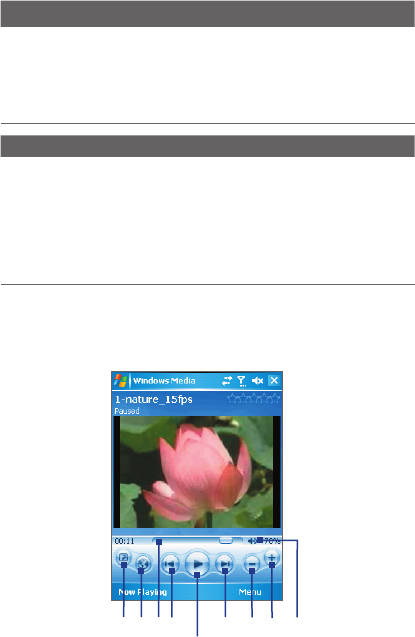
Experiencing Multimedia 163
Video File Formats Supported File Extensions
• Windows Media Video
• MPEG4 Simple Profile
• H.263
• Motion JPEG
• 3GPP2
.wmv, .asf
.mp4
.3gp
.avi
.3g2
Audio File Formats Supported File Extensions
• Windows Media Audio
• MP3
• MIDI
• AMR Narrow Band
• AMR Wide Band
• AAC
• 3GPP2
.wma
.mp3
.mid, .midi, .rmi
.amr
.awb
.m4a
.gcp
About the controls
The following are available controls on the Windows Media
Player.
1
235678
49
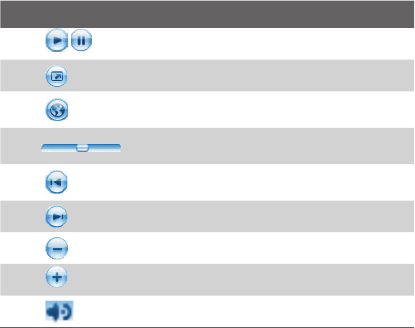
164 Experiencing Multimedia
This control Does this
1 Plays/Pauses a file.
2Displays the video in full screen.
3Displays a Web site where you can find music
and videos to play.
4Adjusts the playback progress of a selected
file.
5Skips to the beginning of the current file or
to the previous file.
6Skips to the next file.
7Decreases the volume level.
8Increases the volume level.
9Turns the sound on or off.
About the screens and menus
Windows Media Player has three primary screens:
• Playback screen. The default screen that displays the
playback controls (such as Play, Pause, Next, Previous,
and Volume) and the video window. You can change the
appearance of this screen by choosing a different skin.
• Now Playing screen. The screen that displays the Now
Playing playlist. This special playlist indicates the current
file being played and any files that are “queued up” to
play next.
• Library screen. The screen that lets you quickly find
your audio files, video files, and playlists. It contains
categories such as My Music, My Videos, My TV, and My
Playlists.
At the bottom of each screen, you can open a Menu. The
commands on this menu vary, depending upon which screen
you are viewing. For more information about the commands
in these menus, see Help on your device.
Experiencing Multimedia 165
About licenses and protected files
Some content (such as digital media files downloaded from
the Internet, CD tracks, and videos) have associated licenses
that protect them from being unlawfully distributed or shared.
Licenses are created and managed by using digital rights
management (DRM), which is the technology for securing
content and managing its access rights. Some licenses may
prevent you from playing files that have been copied to your
device. Files that have licenses associated with them are called
“protected files.”
If you want to copy a protected file from your PC to your
device, use the desktop Player to synchronize the file to your
device (instead of dragging the file from a folder on your PC
to a folder on your device, for example). This will ensure that
the license is copied along with the protected file. For more
information about synchronizing files to your device and
other mobile devices, see desktop Player Help.
Note You can view the protection status for a file by checking its
file properties (tapping Menu > Properties).
Copy media files to your device
Use the latest version of the desktop Player (Windows Media
Player 10 or later) to synchronize digital media files to your
device (instead of dragging a file from a folder on your PC to a
folder on your device, for example). Using the desktop Player
ensures that licenses are copied with protected files.
Always synchronize the files to a storage card that is inserted
into your device. Do not synchronize to a storage card that
is inserted into a storage card reader. In addition, do not
synchronize to the internal storage location (RAM) in your
device.
To synchronize content to your device automatically
1. Power off your device. Insert a 32-MB or larger storage
card into your device, and turn the power back on.
2. On your PC, start Windows Media Player.
3. Connect your device to your PC.
166 Experiencing Multimedia
4. If you have not set up synchronization between your
device and PC, the Device Setup Wizard opens on your
PC.
5. In the wizard, click Automatic, select the Customize
the playlists that will be synchronized check box, and
then select the playlists that you want to synchronize.
6. Click Finish.
7. The files begin synchronizing to your device. The next
time you connect your device to your PC while the
desktop version of Windows Media Player is running,
synchronization will start automatically.
To synchronize and copy content manually to your device
1. If you have not set up synchronization between your
device and PC, follow steps 1 to 6 in “To synchronize
content to your device automatically”, except that you
should click Manual synchronization.
2. To choose files to synchronize and copy to your device,
do the following:
• Click the Library tab.
• In the rightmost pane, click the drop-down list and
select Sync List.
• In the Playlist which is the leftmost pane, select a
desired playlist.
• In the File List which is the middle pane, multi-select
desired files then drag them to the Sync List.
• Click the Start Sync button found at the bottom of
the Sync List.
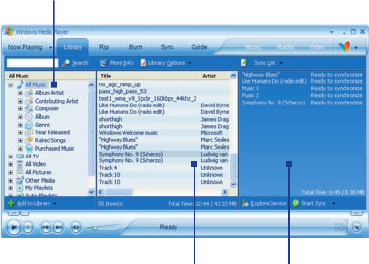
Experiencing Multimedia 167
Playlist
File List Sync List
Note Audio files copy faster if the desktop Player is configured to
automatically set the quality level for audio files copied to
your device. For more information, see desktop Player Help
on the PC.
Play media
To play items on your device
Use the library on Windows Media Player Mobile to find and
play songs, videos, and playlists that are stored on your device
or removable storage card.
1. If you are not on the Library screen, tap Menu > Library.
2. On the Library screen, tap the Library arrow (near the
top of the screen), then tap the media storage that you
want use, for example, Storage Card.
3. In most cases, Windows Media Player Mobile
automatically updates the library. However, you can
manually update the library to ensure that it contains
new files that you recently copied to your device or
storage card. Tap Menu > Update Library to manually
update the library list.
168 Experiencing Multimedia
4. Select a category (for example, My Music or My
Playlists).
5. Tap and hold the item that you want to play (such as a
song, album, or artist name), then tap Play.
Note To play a file that is stored on your device but is not in a
library, on the Library screen, tap Menu > Open File. Tap and
hold the item that you want to play (such as a file or a folder),
then tap Play.
To play an item on a network
Use the Open URL command to play a song or video that is
stored on the Internet or on a network server.
1. If you are not on the Library screen, tap Menu > Library.
2. Tap Menu > Open URL.
3. Do one of the following:
• In the URL box, enter a network address.
• In the History box, tap a URL that you have
previously used.
Note To play an item on a network, you must be connected to
a network. For more information about creating a remote
connection between your device and a network, see
Connections Help on your device.
Use playlists
A playlist is a list of digital media files that play in a specified
order. By using playlists, you can group audio and video files
together for convenient playback.
In the desktop Player, you can create a playlist of media files
and synchronize the desktop Player with your device. For
more information about synchronizing media, see “Copy
media files to your device” earlier in this chapter.
In Windows Media Player on your device, your playlists are
available in the Library under the My Playlists category. There
is also a temporary playlist, called Now Playing, which lists
the currently playing file, as well as any files that have been
queued up to play next. You can create a new playlist on your

Experiencing Multimedia 169
device by saving the current Now Playing playlist and by
giving it a new name.
To save a new playlist
1. If you are not on the Library screen, tap Menu > Library.
2. Tap to select a category (for example, My Music or My
Playlists).
3. Select a media file that you want, then tap Menu >
Queue Up. This adds the file to the Now Playing list.
Repeat this step until you have added all desired media
files to the Now Playing list.
Note You cannot select multiple files simultaneously.
4. After adding the media files, tap Menu > Now Playing.
5. On the Now Playing screen, tap Menu > Save Playlist.
6. Enter the playlist name then tap Done.
7. To play back the playlist you created, tap My Playlists in
the Library, select your playlist, then tap Play.
Troubleshooting
If you encounter a problem while using the Windows Media
Player, a number of resources are available to help you
troubleshoot the issue.
For more information, see the Troubleshooting Windows
Media Player Mobile page at the Microsoft Web site (http://
www.microsoft.com/windows/windowsmedia/player/
windowsmobile/troubleshooting.aspx).
8.4 Using Streaming Media Player
The Streaming Media program allows you to stream live
broadcasts or on-demand media content from the Web.
You do not have to wait until the entire media content is
completely downloaded before watching the video or hearing
the sound. The media is sent in a continuous stream to your
device and is played as it arrives, along with the audio.
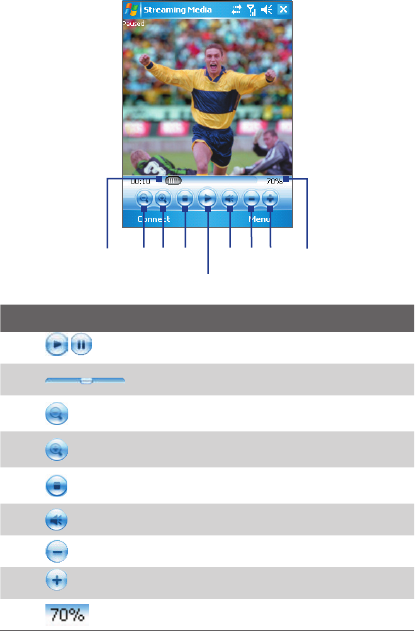
170 Experiencing Multimedia
3 4 5 6 7 8
1
2 9
Button control Function
1 Play/Pause
2Jog Bar (for scrubbing video)
3Zoom out
4Zoom in
5Stop
6Mute
7Decrease volume
8Increase volume
9Current volume level
The Streaming Media program allows you to play 3GP and
MPEG-4 files. It also supports playback of SDP (Session
Description Protocol) files. An SDP file is a text file that
contains the format, broadcast times, media content, and
other information about a live broadcast, or it may contain a
Experiencing Multimedia 171
playlist and links to prerecorded media files if you are viewing
on-demand streaming media.
Tip To always display streaming media in landscape view when
playing in full screen, tap Menu > Options then select the
Use Landscape mode when watching in full screen check
box.
To access streaming content via Internet Explorer Mobile
In Internet Explorer Mobile, you can open a Web page
containing RTSP links to streaming media content then play
the content in the Streaming Media program.
1. Tap Start > Internet Explorer Mobile.
2. In the address bar, enter the URL address of the Web
page that contains the RTSP link to the desired *.3gp,
*.mp4, or *.sdp file.
3. On the Web page, tap the RTSP link.
4. Streaming Media then automatically opens and starts
playing the file. During playback, use the button
controls to play/pause, zoom in or out, adjust the sound
volume, and more.
To stream media files directly on the Streaming Media
program
Streaming Media only supports RTSP links when you stream
*.3gp and *.mp4 files directly on the program.
Note Before you launch the Streaming Media program, make sure
that you are connected to the Internet.
1. Tap Start > Programs > Streaming Media.
2. From the program, tap Connect.
3. Enter the URL for the Web site (rtsp://) and the file name.
Alternatively, if you already accessed RTSP links before,
you can simply tap an RTSP link in the History list to
play previously viewed content.
4. Tap Connect.
172 Experiencing Multimedia
5. Streaming Media then starts playing the file. During
playback, use the button controls to play/pause, zoom
in or out, adjust the sound volume, and more.
To view streaming video file information
You can view the properties and general information of
a streaming video clip, such as file format, audio codec,
dimension, frames, and duration of the video.
• Tap Menu > Properties from the program.
To configure streaming video connection settings
Tap Menu > Options to configure the following settings:
• Connect via. Choose whether you want to connect to
the Internet or corporate network (intranet) to locate a
streaming video clip.
• UDP port range. Specify a range of port numbers to
use for streaming.
• Media buffer. Specify the memory space (in terms of
duration) to allot for storing video and audio data while
streaming media.

9.1 Word Mobile
9.2 Excel Mobile
9.3 Viewing Slide Shows with
PowerPoint Mobile
9.4 Using Adobe Reader LE
9.5 Using Java
9.6 Using ZIP
9.7 Using Voice Speed Dial
Chapter 9
Using Other Applications
174 Using Other Applications
9.1 Word Mobile
Word Mobile is a streamlined version of Microsoft Word. Word
documents created on your PC can be opened and edited
on your device. You can also create and edit documents and
templates in Word Mobile and save them as *.doc, *.rtf, *.txt,
and *.dot files.
You can have only one document open at a time. When you
open a second document, the first one is saved and closed
automatically.
To create a Word file
1. In Word Mobile, tap New. You will see either a blank
document or template, depending on what you have
selected as the default template.
2. Enter text as desired.
3. Tap Menu, then choose whether to set the font,
paragraph alignment and indentation, insert the date,
do a spelling check, and more.
4. When finished, tap OK to save and close the file.
When you close a newly created document, it is automatically
named after the first several words in the document and
placed in the Word Mobile document list. You can easily
rename the document with a more meaningful name and
move it to another folder or a storage card.
Note Word Mobile does not fully support some features of
Microsoft Word such as revision marks and password
protection. Some data and formatting may be lost when you
save the document on your device. To see a complete list of
features that are not supported in Word Mobile, see Help on
your device.
Using Other Applications 175
9.2 Excel Mobile
Excel Mobile makes it easy for you to open and edit Excel
workbooks and templates created on your PC. You can also
create new workbooks and templates on your device.
To create an Excel file
1. In Excel Mobile, tap New. You’ll see either a blank
worksheet or template, depending on what you’ve
selected as the default template.
2. Tap a cell to select it. Using the on-screen keyboard,
enter your data then tap the Enter key.
3. Tap Menu, then choose whether to insert cells, charts,
symbols or functions, format rows and columns, and
more.
4. When finished, tap OK to save and close the file.
Tips • Work in full-screen mode to see as much of your
workbook as possible.
• Tap View > Zoom and select a percentage so that you can
easily read the worksheet.
Note Excel Mobile does not fully support some features such as
formulas and cell comments. Some data and formatting may
be lost when you save the workbook on your device. To see
a complete list of features that are not supported in Word
Excel, see Help on your device.
9.3 Viewing Slide Shows with PowerPoint
Mobile
With PowerPoint Mobile, you can open and view slide show
presentations created on your PC. Slide shows in *.ppt and
*.pps format created using PowerPoint '97 and later can be
viewed in PowerPoint Mobile.
Many presentation elements built into the slide shows such as
slide transitions and animations will play back on the device.
If the presentation is set up as a timed slide show, one slide

176 Using Other Applications
will advance to the next automatically. Links to URLs are also
supported.
Features not supported in PowerPoint Mobile include:
• Notes. Notes written for slides will not be visible.
• Rearranging or editing slides. PowerPoint Mobile is a
viewer only.
• Some file formats. Files created in *.ppt format earlier
than PowerPoint '97 and HTML files in *.htm and *.mht
formats are not supported.
To start a slide show presentation
1. Tap Start > Programs > PowerPoint Mobile.
2. In the presentation list, tap the slide show you want to
view.
3. Tap the current slide to advance to the next slide.
4. To navigate between slides, tap > Next or Previous,
or tap Go to Slide and tap the slide you want to view.
If the presentation is set up as a timed slide show, slides will
advance automatically.
Notes • If you have zoomed in to see a slide in more detail, you
cannot navigate to another slide until you zoom out.
• Tapping Next or Previous may play an animation on a
slide rather than navigate to another slide.
To stop a slide show
• In a PowerPoint Mobile presentation, tap > End
Show.
Using Other Applications 177
9.4 Using Adobe Reader LE
Adobe Reader LE allows you to open and view Portable
Document Format (PDF) files. These files usually have a *.pdf
file extension.
To open a PDF file on your device
1. Tap Start > Programs > Adobe Reader LE.
2. Tap Open.
3. Browse to a folder and tap the PDF file you want to view.
Note To open another PDF file, tap Menu > Open. Tap Browse,
select the desired file, and tap Open. You can also open a PDF
file from File Explorer.
To navigate through a PDF file
You can do any of the following:
• Tap the Up, Down, Right, and Left arrow keys on the
horizontal and vertical scrollbars to move to the desired
direction of the page.
• Press NAVIGATION up, down, right, and left to move up
or down a page or scroll through the pages.
• Tap the space between the arrow keys and the scrollbar
with your stylus to move one screen towards the desired
position.
• Tap and drag the scrollbar tab to quickly scroll through
pages and jump to a desired page number.
• Tap Tools > Go To and select an option to go to a
specific page in a multi-page PDF file.
To enlarge or reduce the display size
1. Open a PDF file you want to view.
2. Tap Tools > Zoom.
3. Select In or Out to enlarge or reduce the display size.
Otherwise, select Fit Screen or Fit Width.
4. Select To % to set an arbitrary zoom ratio.
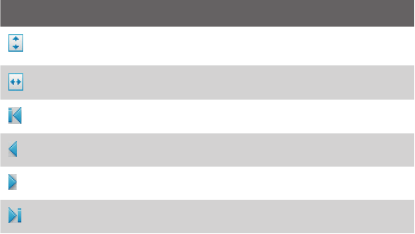
178 Using Other Applications
To customize page view and orientation
1. Open a PDF file you want to view.
2. Tap Tools > View.
3. Select an option to suit your view.
To find text in a PDF file
1. Open a PDF file you want to view.
2. Tap Tools > Find > Text.
3. Enter the text to be searched.
4. Choose search parameters, such as Match case, Whole
word, Backwards, and tap Find.
Note Adobe Reader LE offers you the following advance features.
• It displays a bookmark pane for the PDF files that contain
bookmarks. Tap the bookmarks to go to a specific section/
page within the file.
• It supports password-protected PDF files with up to 128-
bit encryption. When you open a password-protected PDF
file, you will be prompted to enter the password before
the file can be opened.
To use the toolbar
You can also use the Adobe Reader LE toolbar to access the
most commonly used functions. The following table lists the
toolbar controls.
This Control Does This
Fits the entire page to the screen
Fits the page width to the screen
Displays the first page
Displays the previous page
Displays the next page
Displays the last page

Using Other Applications 179
This Control Does This
Displays the text search screen
Zooms out
Zooms in
9.5 Using Java
MIDlets are Java applications such as games and tools that
can run on mobile devices, while a MIDlet suite is a collection
of one or more MIDlets. The Java program lets you download,
install and manage MIDlets or MIDlet suites on your device.
Your device supports Java 2 Micro Edition, J2ME.
To open the Java program
Tap Start > Programs > Java.
Install and launch MIDlets/MIDlet suites
There are several ways to install a MIDlet/MIDlet suite.
To download and install from a URL address
1. On the Java screen, tap Menu > Install > URL.
2. Tap Menu > Add.
3. Enter a descriptive name for the web page.
4. Enter the URL address from where to download. The
web page must contain links to .jad or .jar files.
5. Tap OK. The name of the web page you specified will
then be listed on the screen.
6. Tap the name of the web page, or tap Go.
7. The program will then retrieve the links and display the
file names of MIDlets/MIDlet suites. Select a file name
then tap Install.
180 Using Other Applications
To download and install via Internet Explorer Mobile
1. On the Java screen, tap Menu > Install > Browser to
open Internet Explorer Mobile.
2. Locate the MIDlet/MIDlet suite while connected to the
Internet.
3. Select the MIDlet/MIDlet suite to download.
4. Information about the MIDlet/MIDlet suite is then
displayed. Tap Continue.
5. Confirm to start downloading.
6. Select <root> or a folder where to install the MIDlet
suite to, then tap OK.
To install from your device
You can copy MIDlets/MIDlet suites from the PC to your device
using the USB sync cable, infrared, or Bluetooth connection.
Copy them to the root folder or any subfolder on your device.
1. On the Java screen, tap Menu > Install > Local Files.
The program then searches for MIDlets/MIDlet suites on
your device and displays them in a list.
2. From the list, tap the MIDlet/MIDlet suite that you want
to install.
3. Confirm to start the installation.
4. Select <root> or a folder where to install the MIDlet
suite to, then tap OK.
To run a MIDlet/MIDlet suite
Do one of the following:
• After installation of the MIDlet/MIDlet suite is complete,
tap Yes.
• On the Java screen, open the folder that contains the
MIDlet/MIDlet suite. Select the MIDlet/MIDlet suite then
tap Launch.
To stop running a MIDlet/MIDlet suite
Tap Exit or Quit if presented on the MIDlet/MIDlet suite’s
screen or menu.
Using Other Applications 181
Manage MIDlets/MIDlet suites
You can organize MIDlets/MIDlet suites into folders for
easy identification, move them from one folder to another,
rename or update them, and more. If the device memory is
full, uninstall some MIDlets/MIDlet suites to free up memory
space.
To create folders
1. Tap Menu > New Folder.
2. Enter a folder name then tap Create.
To move a MIDlet to another folder
1. Tap and hold a MIDlet/MIDlet suite then tap Move.
Alternatively, you can tap Menu > Actions > Move.
2. Tap the destination folder.
To rename a MIDlet or folder
1. Tap and hold a MIDlet/MIDlet suite then tap Rename.
Alternatively, you can tap Menu > Actions > Rename.
2. Enter a new name, then tap Save.
To update a MIDlet/MIDlet suite
Tap and hold a MIDlet/MIDlet suite then tap Update.
Alternatively, you can tap Menu > Actions > Update.
Java will search for updates for the selected MIDlet/MIDlet
suite where it was installed from before.
To view information about a MIDlet/MIDlet suite
• Tap Menu > Actions > Info.
• If the MIDlet/MIDlet suite is protected by DRM (Digital
Rights Management), tap Menu > Actions > Protection
to view status and usage rights.
To uninstall MIDlets
Before you uninstall a MIDlet, make sure that it is not running.
1. Tap and hold the MIDlet, and tap Uninstall.
2. Tap OK to confirm.

182 Using Other Applications
Note To uninstall all MIDlets and folders from the current folder,
tap Menu > Uninstall All.
To set MIDlet permission settings
For each MIDlet already installed, Java allows you to
individually set permission options to perform certain actions.
A MIDlet can be enabled to perform these actions:
Action Description
Local connection Enables a MIDlet to access device
connections such as via Bluetooth.
Location
information access
Determines whether a MIDlet can access
location related information.
Recording Enables a MIDlet to record audio and
images.
Messaging Enables a MIDlet to send and/or receive
SMS/MMS. This uses airtime and may incur
costs.
Net access Enables a MIDlet to access the Internet.
This uses airtime and may incur costs.
Auto start Enables a MIDlet to be started
automatically to handle an incoming
event. If there is another MIDlet running, it
may be interrupted.
Read user data Allows a MIDlet to read data on the device
memory or storage card.
Note Some actions may not be available for certain MIDlets.
You can set permission options for performing each action by
following these steps:
1. Tap and hold a MIDlet then tap Security. Alternatively,
you can tap Menu > Actions > Security.
2. For each action, choose one of the following permission
options:
• Always. Enables a MIDlet to perform the action.
• Never. Prohibits a MIDlet to perform the action.
Using Other Applications 183
• Prompt. Asks for your confirmation whenever a
MIDlet attempts to perform the action.
3. Tap Save.
Note Changes to permission settings for a MIDlet in a multi-MIDlet
suite will affect the settings for the whole suite.
9.6 Using ZIP
This feature allows you to save memory and increase the
storage capacity of your device by compressing files in the
conventional ZIP format. You can view and extract archive files
received from various sources. You can also create new *.zip
files on your device.
Start ZIP and Open .zip files
You can use ZIP to either archive files or open an existing
archive file on your device. Each time you start ZIP on your
device, it searches for files that have the .zip file extension,
and displays these files on the Archive List screen.
To start ZIP on your device
• Tap Start > Programs > ZIP.
To open a ZIP file and extract files
1. Open a file using any of the following:
• Select a file and tap File > Open Archive.
• Tap and hold a file and tap Open Archive.
• Double-tap a file.
Note You cannot select multiple ZIP files.
2. The files contained in the zip file are then displayed.
Select files by doing one of the following:
• Tap to select a file.
• To select several files, tap Menu > Action and make
sure Multi-Select Mode is selected. Select files by
tapping each file. (Tap a selected file to deselect it.)
• To select all files, tap Menu > Action > Select All.
184 Using Other Applications
3. Tap Menu > Action > Extract.
4. Choose a folder in which files will be extracted to, then
tap Extract.
To create a zip archive
1. Tap New or File > New Archive.
2. On the Save As screen, enter a zip file name and choose
a folder in which to save the zip file. You can also choose
whether the zip file will be saved on the device’s main
memory or a storage card.
3. Tap Save.
4. Tap Menu > Action > Add.
5. Double-tap the folder that contains the files you want to
archive.
6. Select files by doing one of the following:
• Tap to select a file.
• To select several files, tap and hold on the screen,
then select Multi-Select Mode. Select files by
tapping each file. (Tap a selected file to deselect it.)
• To select all files, tap and hold on the screen, then
tap Select All.
7. Tap Add.
8. Tap Menu > File > Close Archive.
9. After closing the zip file, you can tap Find or Menu >
File > Find Archive to search for all zip files and display
them on the Archive List screen.
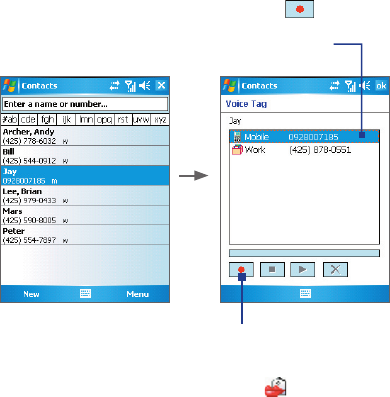
Using Other Applications 185
9.7 Using Voice Speed Dial
You can record voice tags so that you can dial a phone
number or launch programs simply by speaking a word.
Create a voice tag for a phone number
1. Tap Start > Contacts to open the Contacts list.
2. Do one of the following:
• Tap and hold the desired contact, then tap Add
Voice Tag.
• Select the desired contact, then tap Menu > Add
Voice Tag.
• Tap the desired contact to open the contact’s
detailed screen, then tap Menu > Add Voice Tag.
3. Select the phone number that you want to create a
voice tag, then tap the Record button ( ).
Select the desired
phone number.
Tap the Record button to
start recording.
4. When completed, a Voice Tag icon ( ) will be
displayed on the right of the item.

186 Using Other Applications
5. When you create a voice tag for the item, you can do
one of the following:
• Tap the Record button ( ) to rebuild the voice
tag.
• Tap the Play button ( ) to play the voice tag.
• Tap the Delete button ( ) to delete the voice
tag.
Tip To ensure voice recognition accuracy, please record your
voice in a quiet place.
Create voice tag for a program
1. Tap Start > Settings > Personal tab > Voice Speed
Dial.
2. The Application tab displays a list of all installed
programs on your device. The procedure for creating a
voice tag for a program is the same as the procedure for
creating a voice tag for a phone number.
3. After you have created a voice tag for a program, you
can then launch the program by saying the recorded
voice tag after tapping Start > Programs > Voice
Speed Dial.
Make a call or launch programs using voice
tags
1. Tap Start > Programs > Voice Speed Dial.
2. After a “beep” sound, say the recorded voice tag that
you have assigned to the phone number you want to
call or the program you want to launch. The system will
repeat the voice tag and then dial out or launch the
program automatically.
Note If the system cannot recognize your voice tag, please speak
clearly and reduce the surrounding noise, then try again.

Using Other Applications 187
To view and test the voice tags you have created
1. Tap Start > Settings > Personal tab > Voice Speed
Dial.
2. The Voice Tag tab displays a list that contains all the
voice tags you have created. Select an item in the list,
and you can do one of the following:
• Tap the Record button ( ) to rebuild the voice
tag.
• Tap the Play button ( ) to play the voice tag.
• Tap the Delete button ( ) to delete the voice
tag.
188 Using Other Applications
Appendix
A.1 Regulatory Notices
A.2 PC Requirement to Run ActiveSync 4.x
A.3 Specifications
190 Appendix
A.1 Regulatory Notices
Regulatory Agency Identifications
For regulatory identification purposes, your product is
assigned a model number of TITA100.
FCC ID: NM8TITA100. IC: 4115A-TITA100.
To ensure continued reliable and safe operation of your
device, use only the accessories listed below with your
TITA100.
The Battery Pack has been assigned a model number of
TRIN160.
This product is intended for use with a certified Class 2
Limited Power Source, rated 5 Volts DC, maximum 1 Amp
power supply unit.
Federal Communications Commission Notice
This device complies with part 15 of the FCC Rules. Operation
is subject to the following two conditions: (1) This device
may not cause harmful interference, and (2) this device must
accept any interference received, including interference that
may cause undesired operation.
This equipment has been tested and found to comply
with the limits for a Class B digital device, pursuant to Part
15 of the FCC Rules. These limits are designed to provide
reasonable protection against harmful interference in a
residential installation. This equipment generates, uses,
and can radiate radio frequency energy and, if not installed
and used in accordance with the instructions, may cause
harmful interference to radio communications. However,
there is no guarantee that interference will not occur in a
particular installation. If this equipment does cause harm-
ful interference to radio or TV reception, which can be
determined by turning the equipment on and off, the user is
encouraged to try to correct the interference by one or more
of the following measures:
Appendix 191
• Reorient or relocate the receiving antenna.
• Increase the separation between the equipment and
receiver.
• Connect the equipment into an outlet on a circuit
different from that to which the receiver is connected.
• Consult the dealer or an experienced radio or television
technician for help.
Modifications
The FCC requires the user to be notified that any changes
or modifications made to the device that are not expressly
approved by High Tech Computer Corporation may void the
user’s authority to operate the equipment.
FCC Hearing-Aid Compatibility (HAC)
Regulations for Wireless Devices
On July 10, 2003, the U.S. Federal Communications
Commission (FCC) Report and Order in WT Docket 01-309
modified the exception of wireless phones under the
Hearing Aid Compatibility Act of 1988 (HAC Act) to require
digital wireless phones be compatible with hearing-aids.
The intent of the HAC Act is to ensure reasonable access
to telecommunications services for persons with hearing
disabilities.
While some wireless phones are used near some hearing
devices (hearing aids and cochlear implants), users may
detect a buzzing, humming, or whining noise. Some
hearing devices are more immune than others to this
interference noise, and phones also vary in the amount of
interference they generate.
The wireless telephone industry has developed a rating
system for wireless phones, to assist hearing device users
find phones that may be compatible with their hearing
devices. Not all phones have been rated. Phones that are
rated have the rating on their box or a label located on the
box.
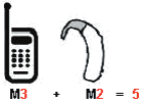
192 Appendix
The ratings are not guarantees. Results will vary depending
on the user’s hearing device and hearing loss. If your
hearing device happens to be vulnerable to interference,
you may not be able to use a rated phone successfully.
Trying out the phone with your hearing device is the best
way to evaluate it for your personal needs.
M-Ratings: Phones rated M3 or M4 meet FCC requirements
and are likely to generate less interference to hearing
devices than phones that are not labeled. M4 is the better/
higher of the two ratings. TITA100 is rated M3.
Hearing devices may also be rated. Your hearing device
manufacturer or hearing health professional may help
you find this rating. Higher ratings mean that the hearing
device is relatively immune to interference noise. The
hearing aid and wireless phone rating values are then
added together. A sum of 5 is considered acceptable for
normal use. A sum of 6 is considered for best use.
In the above example, if a hearing aid meets the M2 level
rating and the wireless phone meets the M3 level rating,
the sum of the two values equal M5. This should provide
the hearing aid user with “normal usage” while using their
hearing aid with the particular wireless phone. “Normal
usage” in this context is defined as a signal quality that is
acceptable for normal operation.
The M mark is intended to be synonymous with the U
mark. The T mark is intended to be synonymous with the
UT mark. The M and T marks are recommended by the
Alliance for Telecommunications Industries Solutions
(ATIS). The U and UT marks are referenced in Section
20.19 of the FCC Rules. The HAC rating and measurement
procedure are described in the American National
Standards Institute (ANSI) C63.19 standard.

Appendix 193
For information about hearing aids and digital wireless phones
FCC Hearing Aid Compatibility and Volume Control:
http://www.fcc.gov/cgb/dro/hearing.html
Gallaudet University, RERC:
http://tap.gallaudet.edu/DigWireless.KS/DigWireless.htm
SAR Information
SAR: 1.130 W/kg @1g (USA)
THIS MODEL DEVICE MEETS THE GOVERNMENT’S
REQUIREMENTS FOR EXPOSURE TO RADIO WAVES.
Use of other accessories may not ensure compliance with the
FCC RF exposure guidelines.
Your wireless mobile CDMA phone is a radio transmitter and
receiver. It is designed and manufactured not to exceed the
emission limits for exposure to radio frequency (RF) energy
set by the Federal Communications Commission of the
U.S. Government. These limits are part of comprehensive
guidelines and establish permitted levels of RF energy for
the general population. The guidelines are based on the
safety standards previously set by both U.S. and international
standards bodies:
• American National Standards Institute (ANSI) IEEE.
C95.1-1992.
• National Council on Radiation Protection and
Measurement (NCRP). Report 86. 1986.
• International Commission on Non-Ionizing Radiation
Protection (ICNIRP) 1996.
• Ministry of Health (Canada), Safety Code 6. The
standards include a substantial safety margin designed
to assure the safety of all persons, regardless of age and
health.

194 Appendix
The exposure standard for wireless mobile CDMA phone
employs a unit of measurement known as the Specific
Absorption Rate, or SAR. The SAR limit set by the FCC is
1.6W/kg*.
The FCC has granted an Equipment Authorization for this
model device with all reported SAR levels evaluated as
in compliance with the FCC RF exposure guidelines. SAR
information on this model device is on file with the FCC and
can be found under the Display Grant section of
https://gullfoss2.fcc.gov/prod/oet/cf/eas/reports/
GenericSearch.cfm after searching on FCC ID: NM8TITA100.
Additional information on Specific Absorption Rates (SAR)
can be found on the Cellular Telecommunications & Internet
Association (CTIA) web-site as http://www.phonefacts.net.
* In the U.S. and Canada, the SAR limit for mobile CDMA phone
used by the public is 1.6 Watts/kg (W/kg) averaged over one
gram of tissue. The standard incorporates a substantial margin
of safety to give additional protection for the public and to
account for any variations in usage.
Normal condition only to ensure the radiative performance
and safety of the interference. As with other mobile radio
transmitting equipment, users are advised that for satisfactory
operation of the equipment and for the safety of personnel, it
is recommended that no part of the human body be allowed
to come too close to the antenna during operation of the
equipment.
IC Statement
Operation is subject to the following two conditions:
1. This device may not cause interference; and
2. This device must accept any interference, including
interference that may cause undesired operation of the
device.
Important Note
IC Radiation Statement:
This equipment complies with IC radiation exposure limits set
forth for an uncontrolled environment. End users must follow
Appendix 195
the specific operating instructions for satisfying RF exposure
compliance.
This Class B digital apparatus complies with Canadian ICES-
003.
Telecommunications & Internet Association
(TIA) Safety Information
Pacemakers
The Health Industry Manufacturers Association recommends
that a minimum separation of six inches be maintained
between a handheld wireless phone and a pacemaker to
avoid potential interference with the pacemaker. These
recommendations are consistent with the independent
research by and recommendations of Wireless Technology
Research. Persons with pacemakers:
• Should ALWAYS keep the phone more than six inches
from their pacemaker when the phone is turned ON.
• Should not carry the phone in a breast pocket.
• Should use the ear opposite the pacemaker to minimize
the potential for interference. If you have any reason to
suspect that interference is taking place, turn the phone
OFF immediately.
Hearing Aids
Some digital wireless phones may interfere with some hearing
aids. In the event of such interference, you may want to
consult your service provider, or call the customer service line
to discuss alternatives.
Other Medical Devices
If you use any other personal medical device, consult the
manufacturer of your device to determine if it is adequately
shielded from external RF energy. Your physician may be able
to assist you in obtaining this information.
Turn the phone OFF in health care facilities when any
regulations posted in these areas instruct you to do so.
Hospitals or health care facilities may be using equipment
that could be sensitive to external RF energy.

196 Appendix
WEEE Notice
The Directive on Waste Electrical and Electronic Equipment
(WEEE), which entered into force as European law on 13th
February 2003, resulted in a major change in the treatment of
electrical equipment at end-of-life.
The purpose of this Directive is, as a first priority, the
prevention of WEEE, and in addition, to promote the reuse,
recycling and other forms of recovery of such wastes so as to
reduce disposal.
The WEEE logo (shown at the left) on the product or
on its box indicates that this product must not be
disposed of or dumped with your other household
waste. You are liable to dispose of all your electronic
or electrical waste equipment by relocating over to
the specified collection point for recycling of such
hazardous waste. Isolated collection and proper
recovery of your electronic and electrical waste
equipment at the time of disposal will allow us
to help conserving natural resources. Moreover,
proper recycling of the electronic and electrical
waste equipment will ensure safety of human health
and environment. For more information about
electronic and electrical waste equipment disposal,
recovery, and collection points, please contact your
local city center, household waste disposal service,
shop from where you purchased the equipment, or
manufacturer of the equipment.
RoHS Compliance
This product is in compliance with Directive 2002/95/EC of
the European Parliament and of the Council of 27 January
2003, on the restriction of the use of certain hazardous
substances in electrical and electronic equipment (RoHS) and
its amendments.
Appendix 197
A.2 PC Requirement to Run ActiveSync 4.x
To connect your device to the PC, you must have Microsoft®
ActiveSync® program installed on your PC. ActiveSync 4.x is
included in the Getting Started Disc, which is compatible
with the following operating systems and applications:
• Microsoft® Windows® 2000 Service Pack 4
• Microsoft® Windows Server® 2003 Service Pack 1
• Microsoft® Windows Server® 2003 IA64 Edition Service
Pack 1
• Microsoft® Windows Server® 2003 x64 Edition Service
Pack 1
• Microsoft® Windows® XP Professional Service Packs 1
and 2
• Microsoft® Windows® XP Home Service Packs 1 and 2
• Microsoft® Windows® XP Tablet PC Edition 2005
• Microsoft® Windows® XP Media Center Edition 2005
• Microsoft® Windows® XP Professional x64 Edition
• Microsoft® Outlook® 98, Microsoft® Outlook® 2000 and
Microsoft® Outlook® XP, and Microsoft® Outlook® 2003
messaging and collaboration clients
• Microsoft® Office 97, excluding Outlook
• Microsoft® Office 2000
• Microsoft® Office XP
• Microsoft® Office 2003
• Microsoft® Internet Explorer® 4.01 or later (required)
• Microsoft® Systems Management Server 2.0

198 Appendix
A.3 Specifications
System Information
Processor QUALCOMM® MSM7500, 384 MHz
Memory - ROM : 256 MB embedded NAND Flash
- RAM : 64 MB SDRAM
(Figures are the total ROM and RAM memory
available for use and storage. Since the memory is
shared by the Operating System, applications, and
data, the actual available memory is less than what
is written).
Operating System Microsoft® Windows Mobile® Version 5.0
Pocket PC Phone Edition
Power
Battery Rechargeable Lithium-ion polymer battery,
1500 mAh
Charging Time Up to 4 hours
AC Adapter Voltage range/frequency: 100 - 240V AC,
50/60 Hz
DC output: 5V and 1A
Display
LCD Type 2.8” transmissive TFT-LCD with backlight
LEDs, touch-sensitive screen
Resolution 240 x 320 dot pixels with 64K colors
Alignment Portrait and Landscape
Cellular Radio Module
Functionality CDMA2000 1xEVDO/1xRTT and IS-95A/B
voice or data
Mode Dual-band (800 and 1900 MHz)
Internal Antenna Yes
Physical
Dimensions 110 mm (L) x 59 mm (W) x 18.5 mm (T)
Weight 165g (with battery)

Appendix 199
Camera Module
Type 2 Megapixel color CMOS camera with flash
light
Resolution Photo: 1600x1200 (UXGA), 1280x960
(SXGA), 640x480 (VGA), 320x240
(QVGA), 160x120 (QQVGA)
Video: 352x288 (CIF), 320x240 (QVGA),
176x144 (QCIF), 128x96
MMS Video: 176x144 (QCIF), 128x96
Digital Zoom Up to 8x
Connections
Infrared IrDA SIR
I/O Port HTC ExtUSBTM : an 11-pin mini-USB and
audio jack in one
(ExtUSB is a proprietary connection
interface that is trademarked by HTC).
Car Antenna
Connector
For connecting to an external phone
antenna (850MHz and 1900MHz)
Wireless
Connections
Bluetooth®, Wi-Fi®
Controls and Lights
Navigation Buttons • 5-way Navigation Control
• Five program buttons : CAMERA, COMM
MANAGER, MESSAGING, INTERNET
EXPLORER MOBILE, VOICE COMMAND
• Two phone functions : TALK and END
• START MENU button
• Two OK buttons
• Two soft keys
• Jog Wheel
• POWER button
• RESET button
• WLAN switch
Hardware
Keyboard
QWERTY keyboard with two additional soft
keys, and an ambient sensor that detects
low light and automatically illuminates the
keyboard.

200 Appendix
Controls and Lights
LEDs The left LED shows the following:
• A blinking Blue light for Bluetooth system
notification of powered-up and ready to
transmit radio frequency signal.
• A blinking Green light for Wi-Fi status.
• When both Bluetooth and Wi-Fi are
enabled, their lights blink alternately.
The right LED shows Green and Amber
lights for CDMA standby and network
status, notification, and battery charging
status.
Audio
Audio Controller AGC
Microphone/
Speaker
Built-in/Dual, Hands-free
Headphone MP3/WAV/WMA/AAC/AAC+ codec
Expansion Slots
Memory Card Slot microSDTM
Index
202 Index
A
A2DP 99
About licenses and protected
media 165
ActiveSync
- Comm Manager 96
- copy files 84
- install and set up 58
- overview 30
- synchronize 62
Add and remove programs 81
Add attachment to message
120
Adobe Reader LE
- overview 30
- use 177
Alarm 77
Answer/end a call 50
Appointment search 43
Assign pictures to contacts 162
Assign programs or shortcuts to
hardware buttons 77
Attachments 120
B
Backlight 79, 80
Battery
- battery information 22
- charge battery 23
- check battery power 23
- save battery power 79, 107
Beam
- via Bluetooth 100
- via Infrared 161
Block Recognizer 40
Bluetooth
- Bluetooth modem 104
- hands-free headset 99
- modes 97
- overview 96
- partnership (pairing) 97
- stereo headset 99
- synchronize 67
- turn on and off 96
- visible 97
Burst capture mode 145
Button controls and LEDs 199
C
Calculator 30
Calendar 30, 132
Calendar search 43
Calibration 25
Camera
- capture modes 144, 145
- controls 146
- file formats 145
- icons 146
- overview 30
- settings 153
- specifications 199
Change
- device name 76
- screen text size 78
Clock & Alarms 33, 76
Close program 84
Comm Manager 34, 95
Compose messages 118
Conference call 54
Index 203
Connect device to Internet
- set up dial-up connection to
ISP 90
- start a connection 92
Connect to private network 91
Contacts 30, 133
Contacts Picture capture mode
145
Contacts search 43
Cookies 94
Copy
- files between device and
PC 84
- files to storage card 84
- media files from PC to device
165
- pictures and video clips from
PC to device 158
Customize
- Start menu 75
- Today screen 74
D
Date 76
Delete pictures and videos 160
Dial-up to ISP 90
Digitally sign messages 70, 122
Digital Rights Management
(DRM) 165
Digital signature
- sign and encrypt 122
- verify 122
Dimensions and weight 198
Direct Push 65, 95
Disconnect data services 96
Download Agent 30
Download messages 121
Draw 140
E
E-mail
- IMAP4 115
- Outlook 114
- POP3 115
- search 43
- security 69
- settings (POP3/IMAP4) 116
- setup wizard 114
Edit picture 160
Emergency call 55
Encrypt messages 70, 122
Excel Mobile 30, 175
Exchange Server
- schedule synchronization
65
- synchronize 64
Exclude e-mail address when
replying to all 120
F
Favorites (Internet Explorer) 93
File Explorer 30
Find
- device information 79
- operating system version
number 79
Find contact
- online 135
- on device 135
Forward message 118
204 Index
G
Games 30
GIF animation 159
H
Hard reset 88
Help 30
Help search 43
Home page (Internet Explorer)
92
I
IMAP4 115
Infrared (IR)
- beam picture or video 161
- synchronize 67
Input methods
- Block Recognizer 40
- Keyboard 39
- Letter Recognizer 39
- Symbol Pad 42
- Transcriber 40
Input Panel 38
Install and set up ActiveSync 58
International call 55
Internet Explorer Mobile 30, 92
Internet security settings 94
Internet Sharing 30, 109
J
Java
- create folders 181
- install MIDlets/MIDlet suites
from device 180
- install MIDlets/MIDlet suites
from Internet 179, 180
- manage MIDlets/MIDlet
suites 181
- move MIDlet to another
folder 181
- overview 30
- rename MIDlet or folder 181
- set MIDlet permission
settings 182
- uninstall MIDlets 181
- update a MIDlet/MIDlet suite
181
K
Keypad tone 80
L
Language 76
Letter Recognizer 39
Library screen (Windows Media
Player Mobile) 164
M
Mail search 43
Make call
- from Call History 49
- from Contacts 48
- from Phone program 48
- from Speed Dial 49
Media synchronization settings
68
Memory 83, 198
Messaging
- IMAP4 115
Index 205
- MMS 123
- Outlook e-mail 114
- overview 31
- POP3 115
- SMS 118
MIDlet/MIDlet suite 179
MMS
- add audio clip 128
- add photo/video 127
- add text 128
- create and send 126
- MMS settings 124
- overview 123
- reply message 129
- view message 129
MMS Video capture mode 145,
150
MSN Messenger 130
Mute 55
N
Notes 31, 43, 139
Notes search 43
Now Playing screen (Windows
Media Player Mobile) 164
O
On-screen keyboard 39
Open PDF file 177
Optional phone services 81
Outlook e-mail 114
Owner information 87
P
Panorama capture mode 145
Password 86
PDF 177
Personal and system settings
77
Phone 31, 46, 48
Phone services 81
Phone settings 80
Pictures & Videos
- assign pictures to contacts
162
- delete 160
- edit picture 160
- file formats 158
- overview 31
- play GIF animation 159
- play videos 159
- sort 160
- view pictures 158
- view slideshows 160
Picture Theme capture mode
145
Playback screen (Windows
Media Player Mobile) 164
Playlists 168
Play GIF animation 159
Play media 167
Play videos 159
Pocket MSN 31, 130
POP3 115
PowerPoint Mobile 31, 175
Programs
- ActiveSync 30
- Adobe Reader LE 30, 177
- Calculator 30
- Calendar 30, 132
206 Index
- Camera 30, 144
- Comm Manager 34, 95
- Contacts 30, 133
- Download Agent 30
- Excel Mobile 30, 175
- File Explorer 30
- Games 30
- Help 30
- Internet Explorer Mobile
30, 92
- Internet Sharing 30, 109
- Java 30, 179
- Messaging 31, 114
- Notes 31, 139
- Phone 31, 48
- Pictures & Videos 31, 158
- Pocket MSN 31, 130
- PowerPoint Mobile 31, 175
- Search 31, 43
- Streaming Media 31
- Streaming Media Player 169
- Tasks 31, 137
- Terminal Services Client 31,
110
- Text Messages Retry 31
- Voice Speed Dial 31, 185
- Windows Media Player
Mobile 31, 162
- Word Mobile 31, 174
- ZIP 31, 183
Put call on hold 54
R
Receive call 50
Receive messages 118
Record voice note 141
Regional options 76
Regulatory notices 190
Reply message 118, 120
Reply MMS 130
Reset
- hard reset 87
- soft reset 87
Review screen (Camera) 150
Ringer 96
Ring tone 80
Ring type 80
S
Save picture from Web page 94
Search 31, 43
Secure/Multipurpose Internet
Mail Extension (S/MIME)
69
Security settings (Internet
Explorer) 94
Send messages 118
Send pictures and videos via
e-mail 161
Settings (Connections tab)
- Beam 34
- Bluetooth 34
- Connections 34
- USB to PC 34
- Wi-Fi 34
- Wireless LAN 34
Settings (Personal tab)
- Buttons 32
- Input 32
- Lock 32
- Menus 32
- MSN Options 32
- Owner Information 32
- Phone 32
Index 207
- Sounds & Notifications 32
- Today 32
- Voice Speed Dial 32
Settings (System tab)
- About 33
- Backlight 33
- Certificates 33
- Clear Storage 33
- Clock & Alarms 33
- Device Information 33
- Error Reporting 33
- Key Lock 33
- Memory 33
- Microphone AGC 33
- Power 33
- Regional Settings 34
- Remove Programs 34
- Screen 34
Set picture as Today screen
background 161
Smart Dialing 50
SMS 118
Soft reset 87
Sounds & Notifications 78
Speakerphone 54
Specifications 198
Speed Dial 49
Sports capture mode 145
Start menu 75
Still image capture modes 149
Storage card
- check available space 83
- copy files 84
- synchronize 68
Streaming Media Player 31, 169
Swap/switch calls 54
Symbol Pad 42
Synchronize
- ActiveSync 62
- change information types
63
- music, video, and pictures
68
- Outlook information with
computer 63
- Outlook information with
Exchange Server 64
- schedule synchronization
with Exchange Server
65
- via Bluetooth 67
- via Infrared 67
- Windows Media Player 68,
165
Sync Setup Wizard 58
System information 198
T
Tasks 31, 137
Tasks search 43
Temporary Internet files 94
Terminal Services Client 110
Text Messages Retry 31
Text size
- screen 78
- Web pages 93
Time 76
Today Screen 26
Today screen customization 74
Transcriber 40
Troubleshoot Windows Media
Player 169
Turn device on and off 24
Turn phone function on and off
46, 95
208 Index
U
USB modem 109
V
Verify digital signature 122
Vibrate 47, 96
Video capture mode 149
View
- MMS 129
- photo slideshows 160
- pictures 158
Voice call 48
Voice note 141
Voice Speed Dial
- create voice tags 185
- overview 31, 185
Voice tags
- create for phone numbers
185
- create for programs 186
- use 186
Volume 47
W
Web pages
- layout 93
- text size 93
Wi-Fi 105
Windows Media Player Mobile
- file formats 162
- menus 164
- overview 31
- playlists 168
- troubleshoot 169
Word Mobile 31, 174
Z
ZIP
- create archive 184
- open zip file and extract
files 183
- overview 31, 183
Zoom (Camera) 151